Boxer Dog History
For the comfort and easiness for our readers, we have summarized the all-inclusive facts about the boxer dog in this encyclopedic study comprising of its basic information and details in a comprehensive manner. Boxer dog was firstly developed in Germany that was eventually come out in a medium-sized and short-haired form having a compact skin or coat with powerful skull and a strong jaw. Boxer dog is a brachycephalic breed normally coming in fawn and bridled colours, sometimes with or without markings and sometimes in white as well.

Their muscular jaws are useful for having a firm and athletic grip on an object. It is also to be remembered, the boxer dog was bred from the Old English Bulldog and the Bullenbeisser which is now extinct. Boxer dog breed belongs to the Molosser group and it is generally considered as a working dog, originally trained to protect the cattle and livestock. Boxer dog breed got immense popularity which ultimately resulted it being one of the most desired house-dogs by the dog lovers around the globe. In the United States of America, boxer dog is the 7th most popular dog breed. However, American Kennel Club has listed it as no. 8 among all trendy choices for dog-keepers.
Average life-span of a boxer dog
One of the most alarming fats about a boxer dog is its shorter life-span, which is due to many factors including anxiety, fear, feeling of loneliness and certain diseases to which the boxer dog is prone. The average life span of a boxer dog is approximately 10-12 years. The major disease which threatens the life of a boxer dog is ‘Cancer’, and according to an estimate, almost half of the boxer dog population between 8- 10 years in the world suffer from cancer. Nervous break-down or mental chaos is also a great risk for the life of the boxer dog.
Similarly, some other wounds or injuries that are not healed in time or left un-treated can become harmful for boxer dog as well. The genetic influence of transmitting the germs of certain diseases by the parent to newly bred boxer dog also plays a significant role in shortening the life-span of a boxer dog. In view of these all, the boxer dog lovers are always curious to find the solution for the longevity of their boxer dog. The best solution is to keep them and their environment clean and provide them with a balanced diet. Safe drinking water is also the key through which you can bring longevity in your boxer.
Read more about Life-span of boxer dog
1.Boxer puppy
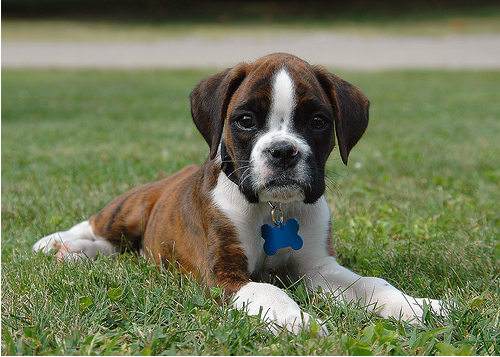 Boxer puppies are so delightful and loveable for their playful cuteness. They are full of energy and look extraordinarily stunning while running and hoping here and there. They become the blue-eyed for whole family members especially for the kids. While playing, when they box with their adorable little paws, the scene becomes absolutely fascinating. Their small but unique face really gives a warm and dainty look and it always seem like smiling. Although they are super-awesome, yet they can be stubborn at some times if they are not met with due care and attention.
Boxer puppies are so delightful and loveable for their playful cuteness. They are full of energy and look extraordinarily stunning while running and hoping here and there. They become the blue-eyed for whole family members especially for the kids. While playing, when they box with their adorable little paws, the scene becomes absolutely fascinating. Their small but unique face really gives a warm and dainty look and it always seem like smiling. Although they are super-awesome, yet they can be stubborn at some times if they are not met with due care and attention.
If the situation is not resolved, there can be little aggression in their behaviors so the best way is to get them socialized as early as possible. For the best grooming of a boxer puppy, a nice and appropriate food schedule should be planned and it should be implemented strictly. If there is apprehension of any health problem then a good vet must be consulted without any delay. They are weather sensitive so they must be safeguarded from the harsh weather conditions. Cleanliness is also very important for the better grooming of a boxer pup. Its environment and place should be clean and tidy.
Read more about Boxer puppy
2.Adult boxer
 An adult boxer is medium-sized with flat body and normally coming in fawn, brindle, with or without white marking and black mask. The male adult boxer can attain a height of 25 inches and can weigh from about 65 to 80 pounds (30 to 36 kilograms); while the female adult boxers might grow up to 21 to 25 inches and weigh from about 50 to 65 pounds (22 to 30 kilograms). The most engrossing parts of the body of an adult boxer are obviously its head and jaw. Perhaps these are one of the most wanted traits for a boxer lover, as and when he goes to adopt the boxer.
An adult boxer is medium-sized with flat body and normally coming in fawn, brindle, with or without white marking and black mask. The male adult boxer can attain a height of 25 inches and can weigh from about 65 to 80 pounds (30 to 36 kilograms); while the female adult boxers might grow up to 21 to 25 inches and weigh from about 50 to 65 pounds (22 to 30 kilograms). The most engrossing parts of the body of an adult boxer are obviously its head and jaw. Perhaps these are one of the most wanted traits for a boxer lover, as and when he goes to adopt the boxer.
Dark brown eyed Boxer looks really charming as their eyes give notice of agility and passion inside. With reasonable flexibility, the neck of an adult boxer is sturdy and athletic. There is also a unique arch which travels till the low parts of its body. The back of an adult boxer is well-shaped and really muscular that adds to its beauty. The feet are also short and having the arched toes. To somehow, they resemble like a cat’s feet. The coat whichever colour is that; it is always sting to the body and it gives a tremendous and shiny look.
Read more about Adult boxer
Boxer dog and its breed types
This strongly built and muscular dog breed can be classified into three main types which include; the UK Boxer, the German Boxer and the American Boxer. The UK Boxer is the top favourite among the boxer dog lovers which is due to its adjustability in every type on environment and circumstances. They have small feet, tall knuckles and give a stunning appearance. The UK boxer is known to have a flashy white base in their coat for which they are also prone to sun-burn and other skin diseases. Second one is known as ‘Gemran Boxer’ which is identical for having larger bone size with shiny and smooth skin.
They are very smart and agile. These types of boxers normally fall under the fawn and brindle color, but can be found with white markings close to their feet. Some German boxers are also observed with having black stripes. The American boxer type is identical for having some prominent distinctions comparing to UK and German boxers by having wrinkle-free skin, unique paw shape, knuckles and ankles. To somehow, the American boxer type is considered more stubborn and moody than the other boxer types. However, all of the types are having playful, loving and spirited characters.
Read more about Boxer dog breed
1.White Boxer Dog
 When the breeders were willing to produce boxer dog, the main idea was to eliminate the dominance of white colour from its skin. But still, the white boxer dog is having a ratio of 20% among the whole world boxer population. White boxer is also one of the most desired choices by the boxer-lovers. Some might confuse this as being albino but the fact is against this.
When the breeders were willing to produce boxer dog, the main idea was to eliminate the dominance of white colour from its skin. But still, the white boxer dog is having a ratio of 20% among the whole world boxer population. White boxer is also one of the most desired choices by the boxer-lovers. Some might confuse this as being albino but the fact is against this.
White boxer dog actually possesses a light tawny skin with having larger white marks spread all over its coat. The noses of the white boxer dogs are spotted with black that normally start to grow, when the pup is one week older and almost whole nose is filled by 16 weeks.
Deafness is among white boxer dog and due to their shiny white coat and skin they are also prone to sun-burns and other likely skin diseases. Deafness is the result for the lack of pigment in the cells of the skin lining the ear canals. However, if you are willing to bring up a white boxer pup, then with the suitable environment and with care, it can happily enjoy a healthy and long life. It is also believed, the first bred pack of boxer dogs were born white.
Read more about white boxer dog
2.Black Boxer dog
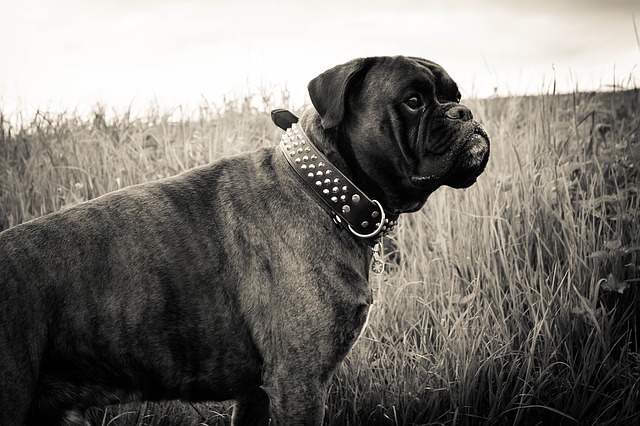 There is wide-spread but misleading information about the existence of black boxer dog. Due to the variety and influence of black on the colour and skin, some breeders might confuse a boxer dog being a black boxer dog but the fact is, there is no genuine black breed of a boxer in the world. When brindle is extremely dark and the black stripes are dominant, it might seem a black boxer dog. Resultantly, it gives fairly black look and appearance to such boxer dog. Generally, all boxer dogs have a fawn base and when the black stripes cover the fawn, it becomes black.There is no clear evidence in the last 100 years, was there any existence of any black boxer dog?
There is wide-spread but misleading information about the existence of black boxer dog. Due to the variety and influence of black on the colour and skin, some breeders might confuse a boxer dog being a black boxer dog but the fact is, there is no genuine black breed of a boxer in the world. When brindle is extremely dark and the black stripes are dominant, it might seem a black boxer dog. Resultantly, it gives fairly black look and appearance to such boxer dog. Generally, all boxer dogs have a fawn base and when the black stripes cover the fawn, it becomes black.There is no clear evidence in the last 100 years, was there any existence of any black boxer dog?
Although, some breeders are attempting to produce a pure black boxer dog, but still there is no success. Some breeders even allure some boxer lovers by advertising as they are having black boxer dog but they must know the truth, there is no presence of pure-bred black boxer dog. The reason is the non-existence of the colour-gene which can be culpable of a boxer dog being black. So better is, not to concentrate on finding a black boxer dog!
Read more about Black boxer dog
3.Boxer dog without marking
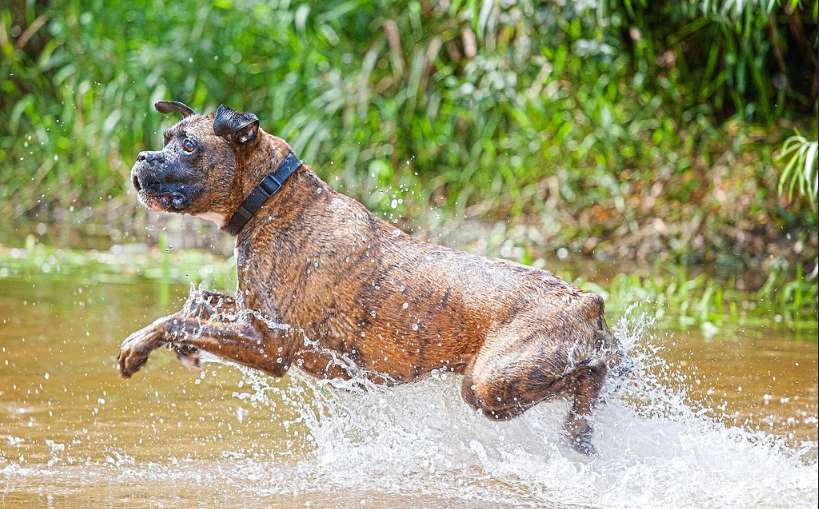 Boxer dogs which having marking are commonly the most wanted choice but believe you us, the boxer dogs without markings are also tantalizing and they give a majestic look. There number is very few in the whole population of boxer dogs in the world. Like cats, the boxer dog has a tendency to keep itself clean and when you find a boxer with a plain skin giving an extraordinary glow, it can be a treat to watch! Boxer dog without markings are actually born without having the existence of SS gene.It might happen, if two SS gene holder boxers are bred together. The offspring will come plain and normally without any marking over their bodies.
Boxer dogs which having marking are commonly the most wanted choice but believe you us, the boxer dogs without markings are also tantalizing and they give a majestic look. There number is very few in the whole population of boxer dogs in the world. Like cats, the boxer dog has a tendency to keep itself clean and when you find a boxer with a plain skin giving an extraordinary glow, it can be a treat to watch! Boxer dog without markings are actually born without having the existence of SS gene.It might happen, if two SS gene holder boxers are bred together. The offspring will come plain and normally without any marking over their bodies.
So in this way, the gene which is responsible for developing the marking is absent, then the boxer dog might come as having no marking on its coat. Plain boxers or boxer dogs without markings possess equal features as other normal boxer dog types are having. They are absolutely wonderful performers, stunning play-mates and gorgeous fun-lovers. If they are provided with the equal opportunities of learning and are given appropriate training, they will behave in the same way as other types express.
Read more about Boxer dog without marking
4.German Boxer dog
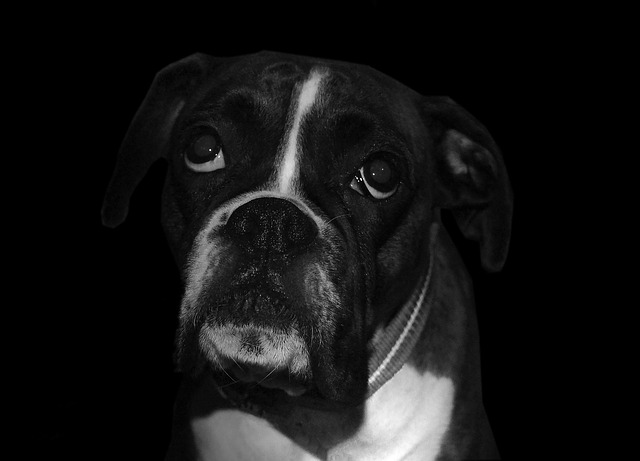 The German boxer dog type is different than the other two major types of boxer dogs, known as American and UK boxers and the main difference is their larger bone size. The adult male German boxer possesses the height approximately between 22.5 and 25 inches. The female German boxer dog keeps the height between approximately 21 inches to 23.5 inches. And when it comes to the weight of an average German boxer dog, it is usually 65 pounds for a male and 55 pounds for a female. However, the other characteristics are almost the same along with the colour scheme and markings on the body.
The German boxer dog type is different than the other two major types of boxer dogs, known as American and UK boxers and the main difference is their larger bone size. The adult male German boxer possesses the height approximately between 22.5 and 25 inches. The female German boxer dog keeps the height between approximately 21 inches to 23.5 inches. And when it comes to the weight of an average German boxer dog, it is usually 65 pounds for a male and 55 pounds for a female. However, the other characteristics are almost the same along with the colour scheme and markings on the body.
Similarly, the attitude, behavior, skills and temperament of German boxer dog are the same as other types do have.Although the bloodline might influence in the aggression or agility but still the common features are same. Generally in Europe, as the ear cropping and tail-docking is strictly forbidden, so one might consider there is also some distinction in the shaping traits. The nose size of a German boxer dog is relatively smaller but to a very few extent. The thigh structure of a German boxer can be marginally wider than UK and American boxer dogs.
Read more about German Boxer dog
5.UK Boxer dog
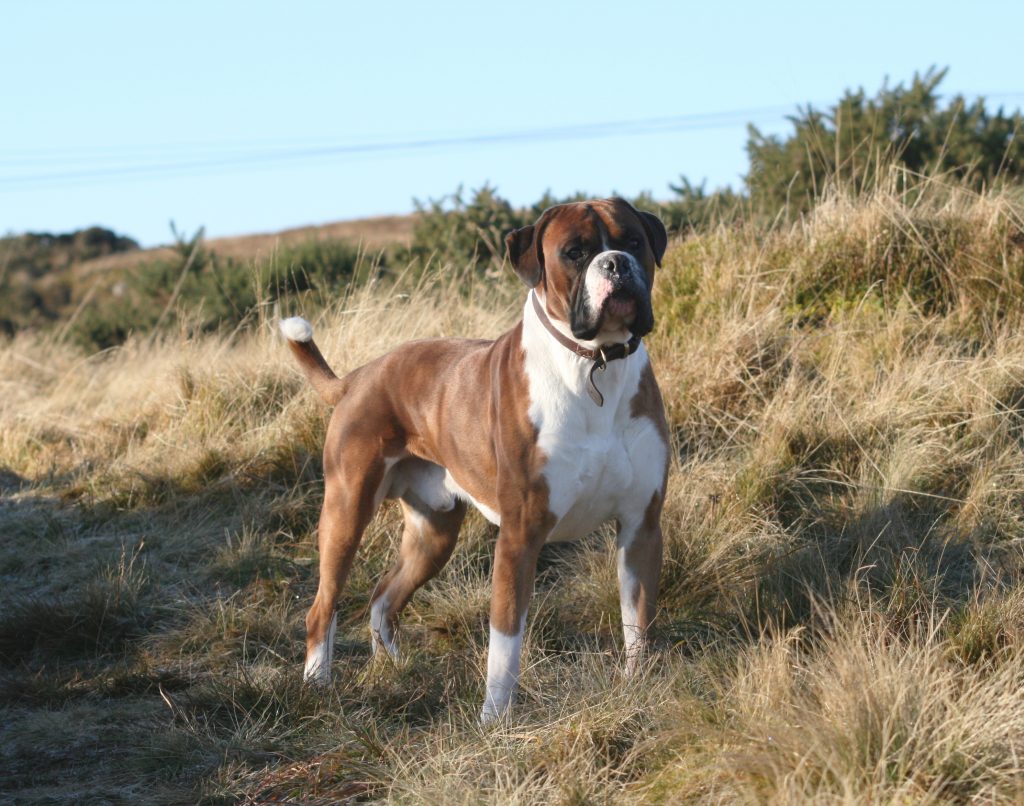 Generally speaking, UK boxer dog and American boxer dog are considered as a same breed. There are only few differences as they can have different styles. Otherwise they keep the same clown characteristics as the other boxer dog types are having. They are tremendously known as brilliant house dogs not only in the Great Britain but also in other parts of the world. They are intelligent and playful but must be given suitable handling and training. They need at least 2 hours for play and exercise in a day.
Generally speaking, UK boxer dog and American boxer dog are considered as a same breed. There are only few differences as they can have different styles. Otherwise they keep the same clown characteristics as the other boxer dog types are having. They are tremendously known as brilliant house dogs not only in the Great Britain but also in other parts of the world. They are intelligent and playful but must be given suitable handling and training. They need at least 2 hours for play and exercise in a day.
The life span of a UK boxer dog on an average is 10 years which is almost the same as the other two famous types known as the German boxer and the American boxer. UK Boxer dogs are also known to have the instinct of tracking and are trained in the armed forces as the messengers and the pack-carriers. For the exact determination of the bloodline of a UK boxer dog, the exact traces of the bloodlines can be provided by the breeder. Some breeders can mix the bloodlines while some can have very strict rules not to mix the blood lines. The energy and stamina is purely dependent upon the training which is provided to a boxer dog.
Read more about UK boxer dog
6.American Boxer dog
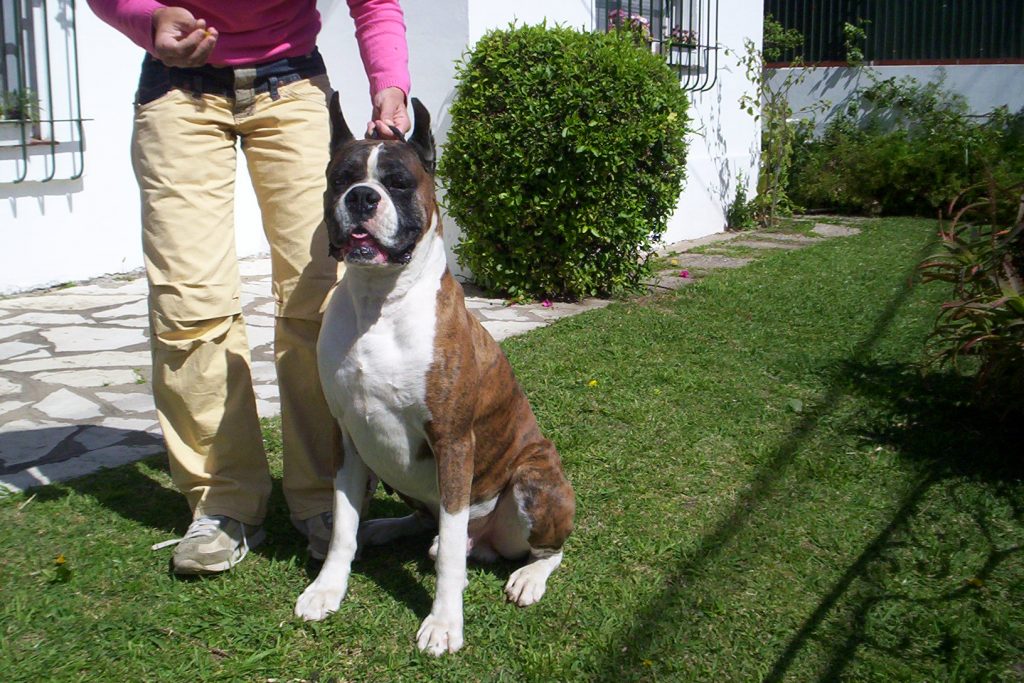 The most prominent distinction between an American Boxer and the German Boxer or UK Boxer is the compact, inflexible and glowing skin. If you keenly observe an American boxer dog, apart from the head part, all other skin will be having no wrinkles. Majority will give a smart and sharp look. There is also a major difference in the shape of the paws, knuckles and ankles than German and UK boxer dogs.
The most prominent distinction between an American Boxer and the German Boxer or UK Boxer is the compact, inflexible and glowing skin. If you keenly observe an American boxer dog, apart from the head part, all other skin will be having no wrinkles. Majority will give a smart and sharp look. There is also a major difference in the shape of the paws, knuckles and ankles than German and UK boxer dogs.
The muzzle and nose parts on head can also be slightly broader than the German or UK Boxer.American boxer dogs also come in various types of colouring including brindle, fawn and white. The American boxer dog has also a fantastic inclination to hind legs and “box” with front paws. An American boxer dog namely Brandy, belonging to Michigan holds the record of having the longest tongue in the world. As comparing to Europe, there are no restrictions in the US for cropping the ears and docking their tails, the American Boxer dog owners do this, so any wild predator might not be able to grab a hold of them as easy when hunting. Nowadays as the bloodlines are mixed by the breeders, it doesn’t make a difference for a boxer lover to go for a pure American boxer bloodline.
Read more about American boxer dog
Boxer dog appearance
Boxer dog is absolutely athletic and it belongs to the Mastiff family. It is known for having a medium-sized but quite muscular body along with broad and black muzzles which give them a unique look among all dog breeds in the world. The muzzle is usually one third the lengths of the head and two thirds the width of the skull. Mostly boxer dog owners do follow the trend to crop their ears and dock their tails. The coat and skin is short-haired with the normal shading of fawn or brindle.
The average height of an adult male boxer dog is between 22 and 25 inches, while the adult female boxer dog might be taller up to 23.5 inches. The male boxer dog weighs around 70 pounds while the adult female boxer dog weighs around 58 pounds on an average. With the moderate shedding trend, boxer dog breed is fairly tolerable. The main reason is the tight-fitting coat with slight fur on their skin. If you ask about the recognized and admitted colour of the skin or coat of the boxer dog, those are fawn and brindle. Additionally, they can have the white markings around neck or close to legs and feet and those are known as flash.
Read more about Boxer dog Appearance
1.Boxer dog face
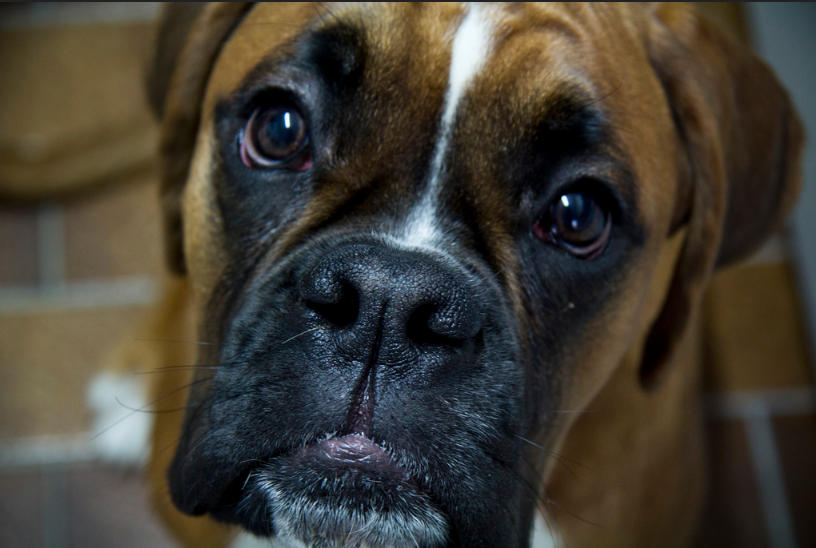 When it comes to the facial features of a boxer dog, the most prominent is the head of a boxer dog. According the boxer breed standards, the size of the head of a boxer dog must have a splendid fraction in accordance with the rest of the body but along with this, the size of its head also should not have light weight. The nose or the muzzle of a boxer dog must not give a sharp look but it should be in a bit rounded form.
When it comes to the facial features of a boxer dog, the most prominent is the head of a boxer dog. According the boxer breed standards, the size of the head of a boxer dog must have a splendid fraction in accordance with the rest of the body but along with this, the size of its head also should not have light weight. The nose or the muzzle of a boxer dog must not give a sharp look but it should be in a bit rounded form.
Ideally the size of the muzzle or nose is one third of the length of the whole head and two third of the width of the head.The creases and crumples rarely exist on the face of a boxer dog but only when their brows are furrowed. It means, if a boxer dog is erecting its ears, the wrinkles will be appearing on its face. As far as the eyes of a boxer dog are concerned, those are dark and not too small hidden slightly into the head skin. The lower part of the jaw of a boxer dog is jut out ahead of the upper part of jaw which is marginally twisted upwards.
Read more about Boxer dog face
2.Ear cropping of boxer dog
 The ear cropping of a boxer dog was a common fashion till few decades ago but in recent times, in most of the countries, it is banned as many animal activist organization voiced against this. Usually the ear cropping in a boxer dog is done so the boxer dog to be kept safe while quarreling with the wild animals especially during hunting. There is also a belief, by cropping the boxer might be able to control on its ears and those can be strong and straight.
The ear cropping of a boxer dog was a common fashion till few decades ago but in recent times, in most of the countries, it is banned as many animal activist organization voiced against this. Usually the ear cropping in a boxer dog is done so the boxer dog to be kept safe while quarreling with the wild animals especially during hunting. There is also a belief, by cropping the boxer might be able to control on its ears and those can be strong and straight.
As it is banned in mostly European countries and in some Asian countries, in the US, some boxer dog owners prefer their boxer dog with cropped ears while some continue their natural look.However, where the ear cropping is lawful, the owners must always go to a proper vet for the ear cropping, as in case of any blunder, there might be the development of infection or virus issues. Ear cropping of Boxer dogs is also banned in some provinces of Canada like Nova Scotia, New Brunswick, Prince Edward Island and Newfoundland and Labrador. Some breeders also apprehend, by banning the ear cropping, there can arise certain health issues in the boxer dog breed.
Read more about boxer dog ear cropping
3.Boxer has loose skin
It is a frequently asked question put before by the boxer dog owners, why the boxer dog has a loose skin? And some might also apprehend, whether their boxer dog is pure-bred or not? But this is a very common feature in the boxer dog breed. The skin of a boxer dog might be especially loose around its neck. Sometimes even the handful of the skin can be grabbed but it does not mean, such boxer dog is over-weight or chubby. As it is described in the boxer dog related literature, you will rarely find a boxer dog with full tight skin and meeting the standards as highlighted by dog clubs.
In the younger age and in the elder age, a boxer dog can normally have creases and wrinkles on its skin or in simple words, a boxer dog will be having a loose skin. In the full young phase of its life, you’ll find the skin of a boxer dog tight and angular. When the boxer dog turns adult, the skin becomes tightened and it is more visible when he looks down. It must also be understood, you can grab its skin handful, but once you’ll leave it, it will settle itself to the same position as it was before.
Read more about Boxer dog loose skin
4.Why a Boxer dog seems so skinny?
Boxer dogs especially, when those are between the age of 14 and 22, they look really slim, skinny and bony but as they grow old, changes occur in their body shapes. In the young age, the boxer puppies are normally without the existence of fats but as soon as they enter in the adulthood, their height increases and they obtain the fats as well. But overall as the Boxer Dog is an active and athletic breed, it wants to be involved in different types of exercises and walks. This is also one of the reasons of their smartness and they seem skinny often.
There is another factor, the boxer dog is food conscious and they take lesser quantity of food than other dog breeds. But still, it depends upon the boxer dog owner, how they train their boxer dog. If we say, a Boxer Dog is determined enough to keep its body in shape by doing exercises and by maintaining a balanced nutritional diet, it might not be wrong. It is a well-known fact, the Boxer has a marvelous playful temperament, which always keeps it energetic and frisky, and so it seems normally skinny.
Read more about why a boxer dog seems so skinny
5.Boxer dog size
Although, sometimes, the boxer dog breed is referred to a large breed, but still it falls under the medium-sized category of dogs. For more understanding, one must know
the categorizations of all “medium” dog breeds range from 35 to 65 pounds (15.8 to 29.4 kg). If the height at withers is measured, on an average, the male boxer dog will fall between 22 to 25 inches while the female boxer dog will fall between 21 to 24 inches. The American Kennel Club has defined, “The ideal Boxer is a medium-sized, square-built dog of good substance with short back, strong limbs, and short, tight-fitting coat.”
There are general standards about the height and size of the boxer dog, the ribcage should drop to the extent that the bottom of the ribcage is touching the elbows while the structural elevation from the earth to the lowest part of the breast is same as the gap between the lowest parts of breast to its withers. If we keep these parameters in our mind, it means a male boxer dog with 22 inches height and a male boxer dog with 25 inches height, both are fit enough to meet the breed standards.
Read more about Boxer dog size
6.Docking Boxer tail
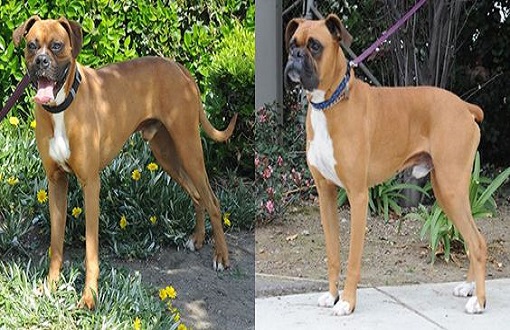 Docking of the tail of a boxer dog is a process through which the tail is cut, so it stays in an erected position and to give it a charming and unique look. Traditionally when it was cut, a rubber band was fixed on the spot to stop the blood flow but nowadays it is docked through a ‘surgery’ in which a specific tail portion is normally cut off. When the boxer dogs were firstly bred, it was probably in the minds of the breeders to dock its tail so it can run fast and smoothly. Later, it was continued to prevent a boxer dog from tail damage. Docking of tails of the boxer dogs is also unlawful in many countries similar to the cropping of ears as there is a protest by animal activist groups or due to the government own policies.
Docking of the tail of a boxer dog is a process through which the tail is cut, so it stays in an erected position and to give it a charming and unique look. Traditionally when it was cut, a rubber band was fixed on the spot to stop the blood flow but nowadays it is docked through a ‘surgery’ in which a specific tail portion is normally cut off. When the boxer dogs were firstly bred, it was probably in the minds of the breeders to dock its tail so it can run fast and smoothly. Later, it was continued to prevent a boxer dog from tail damage. Docking of tails of the boxer dogs is also unlawful in many countries similar to the cropping of ears as there is a protest by animal activist groups or due to the government own policies.
But to many breeders, it is important that the boxer dog should have the docked tail and cropped ears.
People who prefer the docking normally argue, it makes the boxer dogs look stronger, alert and handsome. Many breeders suggest the boxer dog owners to have docked the tail of their boxer dog in its early puppyhood.
Read more about Docking Boxer tail
7.Boxer dog weight
It is important for a boxer dog to maintain a normal weight for its health. If it gains too much weight, it can be dangerous as it might lead to some serious consequences. But if a boxer with obesity is not good, similarly if a boxer dog is underweight; it can also be a major issue. In both conditions, it is suggested to have a complete vet examination because weight gain and loss can be caused by several types of health problems. As per the American Kennel Club guidelines, an adult boxer dog’s weight will range between 60 and 70 pounds (27 to 32 kg) on an average while an adult female boxer dog’s weight will range between 55 to 65 pounds (25-29 kg). Balanced diet is an excellent approach to overcome the boxer dog weight issues.
A good boxer dog owner is always serious about the smartness and weight of its boxer as it plays an important role in its physical grooming and routine exercises. Overweight or underweight boxer will not happily walk, jog or activate itself in several types of exercises. Useful nutrition and fitting physical exertion will maintain an excellent body structure of your boxer.
Read more about Boxer dog weight
8.Boxer dogs paw size and shape
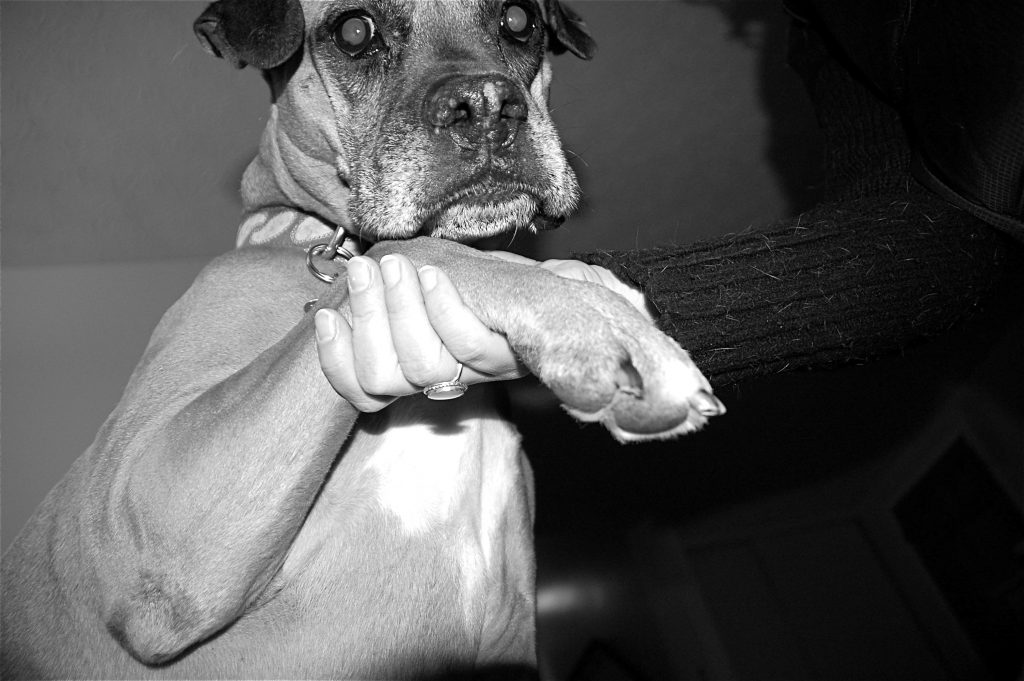 Boxer dog is well-known and famous for its boxing technique with front paws. Nature has designed its paws in a magnificent manner which helps them in exhibiting their athletic tricks in a splendid way. Their paws make them real contender and sporty. When a boxer dog is exciting, it starts playing and it can stand on its hind legs and move its front paws like a human boxer. There is also a skin on a boxer dog’s feet along with some tissues and ligaments which harmonize the blood supply functions as well. The paws of a boxer also include some metacarpal pads which work as shock-observers and also serve in protecting the bones and joints of boxer dog’s feet.
Boxer dog is well-known and famous for its boxing technique with front paws. Nature has designed its paws in a magnificent manner which helps them in exhibiting their athletic tricks in a splendid way. Their paws make them real contender and sporty. When a boxer dog is exciting, it starts playing and it can stand on its hind legs and move its front paws like a human boxer. There is also a skin on a boxer dog’s feet along with some tissues and ligaments which harmonize the blood supply functions as well. The paws of a boxer also include some metacarpal pads which work as shock-observers and also serve in protecting the bones and joints of boxer dog’s feet.
The paw pads also contain some tissues that help in protecting by involving the inner tissues to adjust with the outside temperature. Their paw pads are also beneficial for walking on rough surfaces in a comfortable way. There is a claw located few inches upwards the boxer dog’s paw which is known as ‘dew claw’ and it is used by the boxer dog in chewing, eating bones and grasping or holding a grip on something.
Read more about Boxer dog paw size and shape
Boxer dog’s Behavior
Boxer dog is generally a faithful and loyal dog breed which is quite intelligent and playful as well. There seeming look is also absolutely smashing with muscular and solid appearance. Boxer dog is one of the largest among the medium sized dogs and is popular in dog lover’s community for its devotion and affection towards their owners and their properties. They are regarded as fabulous family pets who love to spend their time with family kids with their entertaining skills. Although they are energetic and rambunctious still they need proper training and guidance to groom well.
They are quite adjustable with other family pets including cats and also with the neighboring dogs and animals. Boxer dog is inherently a working dog breed which is although easily trainable still it requires consistent leadership. A boxer dog can sometimes be stubborn and annoying because it is a sensitive dog which is always desirous to find its owner’s love and attention. Boxer dog is quite social and loneliness can also affect its behavior and habits. Boxer dogs are very strong dogs, so they act by their own. Boxers prefer the vigilant owners who can train and guide them properly, and are always close to them.
Read more about Boxer dog behavior
1.Boxer dog barking
 Barking is the normal reaction of a boxer dog; in fact, it is a way of its communication. But excessive barking shouldn’t be taken lightly as there is always a reason. A boxer dog’s barks can be of several types and every such bark conveys a different emotion. If your boxer is vocalizing in a high volume then there will be certain reasoning. Being a guard dog, boxer dog barks to protect you and your property. It actually makes you alert after assessing any dangerous situation.
Barking is the normal reaction of a boxer dog; in fact, it is a way of its communication. But excessive barking shouldn’t be taken lightly as there is always a reason. A boxer dog’s barks can be of several types and every such bark conveys a different emotion. If your boxer is vocalizing in a high volume then there will be certain reasoning. Being a guard dog, boxer dog barks to protect you and your property. It actually makes you alert after assessing any dangerous situation.
They can also bark if they are in an emotional state or facing a turbulent activity as they are usually responsive to their feelings. Sometimes they also bark on hearing the noise for example, ring of doorbell, or when they hear the voice of neighbor’s dog barking. If they get frightened from certain objects, unknown people and loud noises, they’ll hold their ears back and low down their tails and start barking. Sometimes there is a health problem behind their consistent barking and they are seeking care and attention. Good boxer dog owners teach their boxers what is a perfect time to bark, when not to bark and on which things barking is acceptable.
Read more about Boxer dog barking
2.Boxer Dog Biting
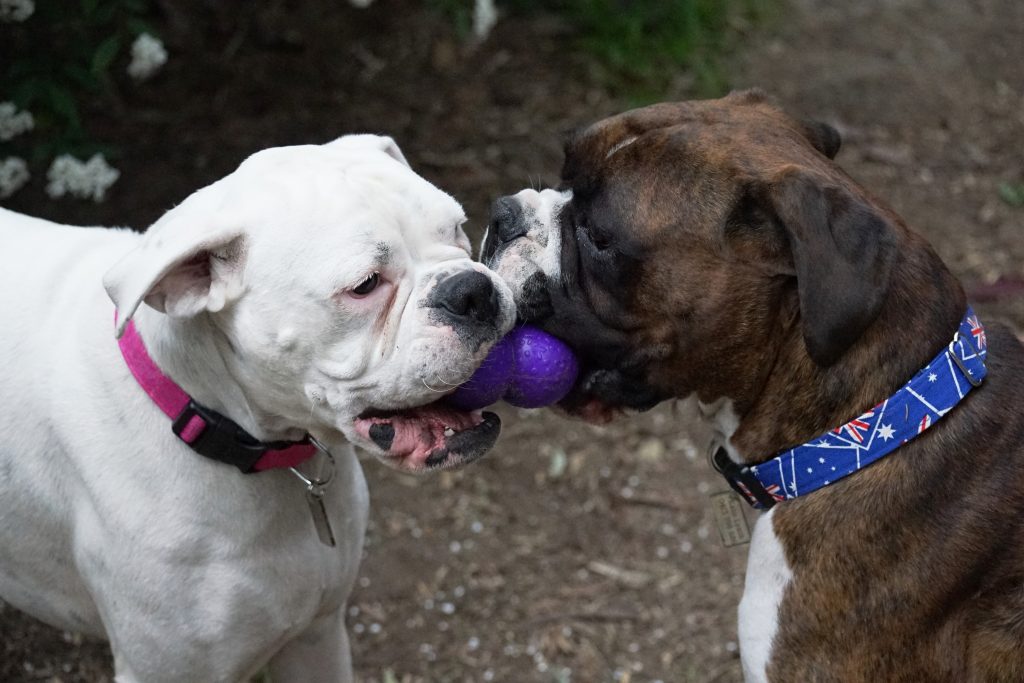 Boxer is a sturdy, powerful and colossal medium-sized dog which is normally human friendly fellow but one should never forger its enormous jaw and sharp teeth. However it is to be remembered, Boxer dog is not considered a riskier pet. If someone among you is desirous to adopt a Boxer, then happily go for it. Boxer, which is actually the result of a crossbreed from the old English bulldog, it was bred for the hunting purposes. So its majestic jaw would have been the pre-planned strategy of its breeder. Boxer is also one of the dogs who can commit the bite attacks. According to an estimate, the average bite force of an adult boxer is in between 220-240 pounds.
Boxer is a sturdy, powerful and colossal medium-sized dog which is normally human friendly fellow but one should never forger its enormous jaw and sharp teeth. However it is to be remembered, Boxer dog is not considered a riskier pet. If someone among you is desirous to adopt a Boxer, then happily go for it. Boxer, which is actually the result of a crossbreed from the old English bulldog, it was bred for the hunting purposes. So its majestic jaw would have been the pre-planned strategy of its breeder. Boxer is also one of the dogs who can commit the bite attacks. According to an estimate, the average bite force of an adult boxer is in between 220-240 pounds.
But this bite force is dependent upon the age of boxer. The size and sex may also create the difference regarding the measurement of the boxer’s bite force. This is a fact; a bite by a boxer could be sometimes seriously damaging and painful. If your boxer is not properly trained, it might possess a serious threat for biting as it has tremendous biting force. A boxer owner should be fully aware about this fact so he/she must give proper training to avoid its rage.
Read more about Boxer dog Bitting
3.Boxer Teething and Chewing Issues
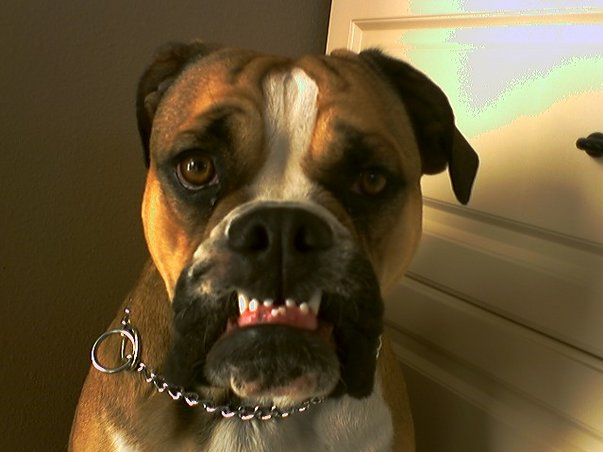 A boxer dog also goes through the teething process. When a boxer’s pup is born, it is having 28 teeth. With the passage of time, the puppy gets older and the teething process is also beginning. This is a phase which requires patience and tolerance by the boxer dog owner as in the teething period, the puppy starts chewing everything that comes to its range. Being a good boxer dog owner, you must not be harsh but you need to train and redirect your pup with fortitude.
A boxer dog also goes through the teething process. When a boxer’s pup is born, it is having 28 teeth. With the passage of time, the puppy gets older and the teething process is also beginning. This is a phase which requires patience and tolerance by the boxer dog owner as in the teething period, the puppy starts chewing everything that comes to its range. Being a good boxer dog owner, you must not be harsh but you need to train and redirect your pup with fortitude.
For your pup’s point of view, this period of its age is of learning the things. It is a normal behavior and the big mouth of your boxer is actually the exploring tool through which he wants to quench the thirst of its curiosity.This is actually a short-lived stage and the things can be normalized with some correction and training. The best way is obviously to teach your boxer puppy in a gentle and pleasing manner. Offer him with the suitable alternatives to chew on. It is also recommended to have a medical examination of your puppy in the teething stage. Because sometimes the nutritional deficiencies caused by inappropriate diet might also result in bad chewing.
Read more about Boxer dog teething and chewing issues
4.Boxer Dog Head bobbing and Shaking
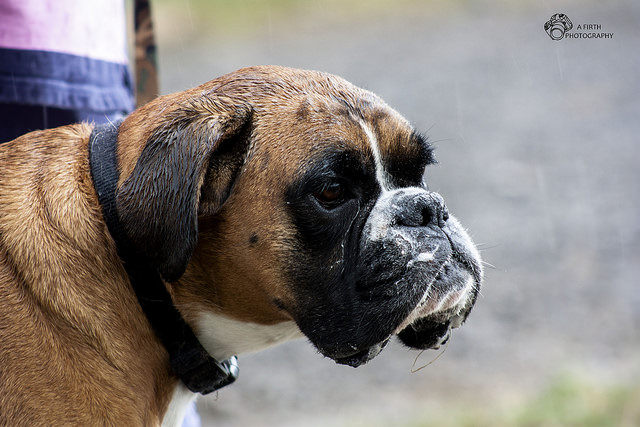 Head-bobbing or shaking is a repeatedly done movement which might be due to an uncontrolled development in a boxer dog’s body which is usually displayed when it is wakeful. Shaking in a boxer dog might happen in various parts of its body and the causes may be different as well. Some examples of the causes include the existence of a tumour inside the head, cerebellum, drugs, head-injury, vestibular maladies and irritation or may be because of hereditary qualities. It is a serious thing which should be taken by a boxer dog owner very seriously.
Head-bobbing or shaking is a repeatedly done movement which might be due to an uncontrolled development in a boxer dog’s body which is usually displayed when it is wakeful. Shaking in a boxer dog might happen in various parts of its body and the causes may be different as well. Some examples of the causes include the existence of a tumour inside the head, cerebellum, drugs, head-injury, vestibular maladies and irritation or may be because of hereditary qualities. It is a serious thing which should be taken by a boxer dog owner very seriously.
Some medical issues like thyroid issues, low glucose, ligament torment, hip dysplasia torment, fever, seizures, epilepsy etc can also be the reasons of boxer dog head-bobbing and shaking. If there is apprehension that there can be a health problem causing such situation then such boxer pup or dog should be brought to a qualified and trust-worthy veterinarian. Some minor issues can be adjusted with little medical care otherwise a proper treatment should be started with prolonged medication. Why this through investigation by a proper vet is important? To rule out rule any other threatening cause such as tumors or head injuries.
Read more about Boxer Dog Head bobbing and shaking
5.How to Calm Down a Hyper Boxer?
 There can be certain frightening issues which can cause a boxer dog to become hyper. We’ve elaborated some ways in detail through which you can calm down your hyper boxer. These are actually some useful suggestions which will not only help you in making your boxer calm but also for making him socially better with people and other dogs. Normally, if your boxer dog clings with you in a hyper mood, then it is desirous for getting your attention and love. If it lies down before you, praise him, pat him and serve him with food treats.
There can be certain frightening issues which can cause a boxer dog to become hyper. We’ve elaborated some ways in detail through which you can calm down your hyper boxer. These are actually some useful suggestions which will not only help you in making your boxer calm but also for making him socially better with people and other dogs. Normally, if your boxer dog clings with you in a hyper mood, then it is desirous for getting your attention and love. If it lies down before you, praise him, pat him and serve him with food treats.
The more you will pay attention to your dog, the less he will get hyper. Bust side by side, the HYPERACTIVITY behavior of a boxer should not be inadvertently strengthened. Through training and practice, you can teach your boxer dog on how to stay calm. If you are frustrated yourself then never express hyperactive behavior to your boxer. Instead, always try to spend a good time with your pet to help him staying calm. As a nice boxer dog owner, you should understand your dog’s needs, for example, calm environment along with sufficient place and diet.
Read more about How to calm down a hyper Boxer?
6.Boxer Dog Separation Anxiety
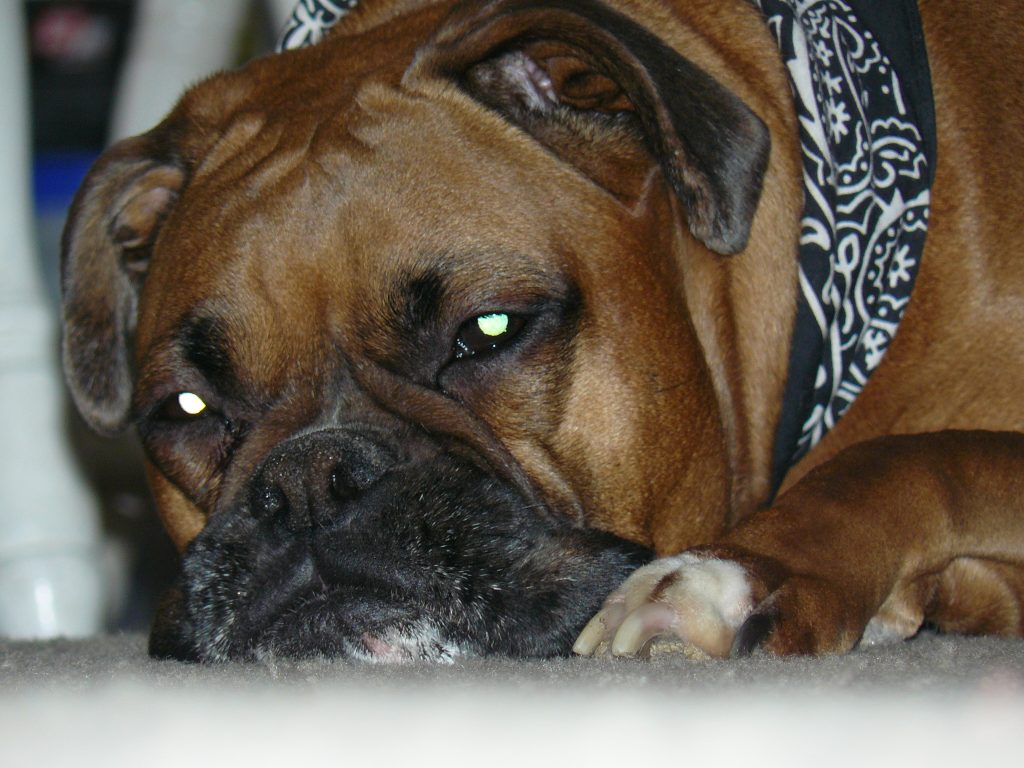 Boxer dog separation anxiety is a complicated issue which is very common among them. The boxer dogs are sensitive which behave like humans, so they also want love, affection, and care from their owners. If a boxer dog owner or family member ignores a boxer dog or don’t give it proper attention or care, such boxer dog might suffer from anxiety situation. In such condition, it is very expressive and it will cry or howl and even devastate the households or furniture.
Boxer dog separation anxiety is a complicated issue which is very common among them. The boxer dogs are sensitive which behave like humans, so they also want love, affection, and care from their owners. If a boxer dog owner or family member ignores a boxer dog or don’t give it proper attention or care, such boxer dog might suffer from anxiety situation. In such condition, it is very expressive and it will cry or howl and even devastate the households or furniture.
There are different levels of the separation anxiety to which boxer dog is prone, for example, some boxers suffer from the mild level of anxiety and others might suffer from sort of major anxiety, which causes major obliteration.Sudden changes in the prevailing circumstances and loneliness feelings can also cause anxieties in your boxer dog. Boxer dog can express its anxiety through different ways like barking, moaning, licking, munching and likewise. Exercise is the best way to overcome the separation anxiety in a boxer dog. Behavior modification method takes time to give the outcome, but it is the permanent solution to this problem. Medication as suggested by a vet might help to some extent as well.
Read more about Boxer Dog Separation Anxiety
7.Boxer Dog Temperament
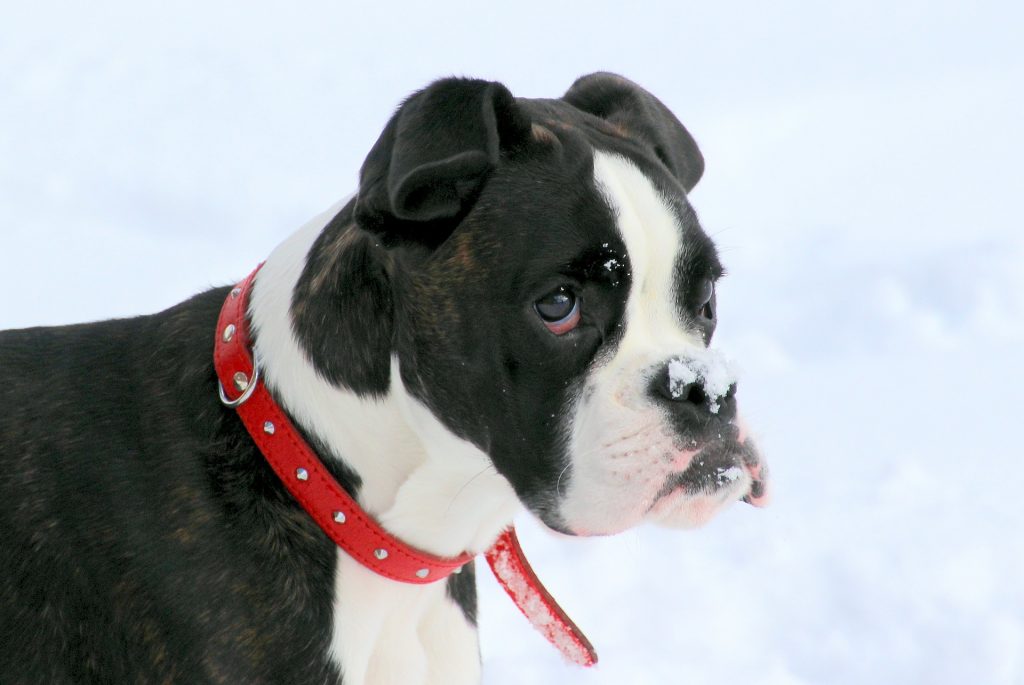 The first impression of a boxer dog can be real imposing due to its herculean appearance but in fact a boxer dog is absolutely rowdy, lively and comical. It is known as a clown and joker dog breed. The puppy boxer is always a cool beginner and remains childish throughout its puppy-hood, but the adult boxers are also animated and spirited play-mates who are keen for the cake walks. Devotedness is one of the fundamental characteristics of a boxer dog.
The first impression of a boxer dog can be real imposing due to its herculean appearance but in fact a boxer dog is absolutely rowdy, lively and comical. It is known as a clown and joker dog breed. The puppy boxer is always a cool beginner and remains childish throughout its puppy-hood, but the adult boxers are also animated and spirited play-mates who are keen for the cake walks. Devotedness is one of the fundamental characteristics of a boxer dog.
He is always there and exuberant for you. Boxer dogs will always surprise you with their awesome intelligence. They have stunning ability to learn the new things and adaptability to the newer environment. They are confident fellows who behave in a superb style.If they are met with appropriate environment, balanced diet and exercising atmosphere, then their confidence goes sky high. They are also gallant and warrior dog always ready to protect their masters and defend their belongings. They will keep alert the owner by alarming them whenever smelling any danger. They are mixed up in the family very soon and become beloveds for the children of the family. They hop with them, entertain them and tickle them with their sprightly skills.
Read more about Boxer Dog Temperament
8.When a Boxer Dog Won’t Listen
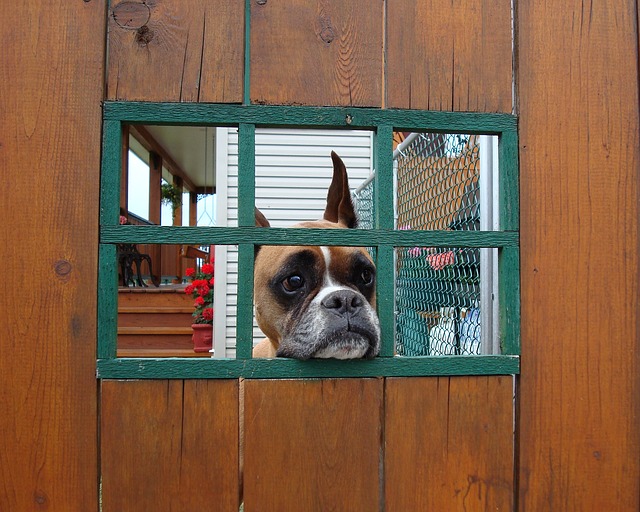 Although boxer is famous in the world for their loyalty and faithfulness, however there might be some circumstances in which a boxer dog won’t listen to you. Such disobediences these cases of disobedience are not only related to some of the adult boxer dogs, but some boxer puppies also don’t pay attention sometimes. Boxer dog breed is unique in the sense as it needs proper attentions, timely feeding, fitness exercises and activities, appropriate grooming, entertaining playthings and stuff like that. In case of such absence or likewise, you boxer might become upset or frustrating and behave in disobedience.
Although boxer is famous in the world for their loyalty and faithfulness, however there might be some circumstances in which a boxer dog won’t listen to you. Such disobediences these cases of disobedience are not only related to some of the adult boxer dogs, but some boxer puppies also don’t pay attention sometimes. Boxer dog breed is unique in the sense as it needs proper attentions, timely feeding, fitness exercises and activities, appropriate grooming, entertaining playthings and stuff like that. In case of such absence or likewise, you boxer might become upset or frustrating and behave in disobedience.
No need to become disappointed, but get involved with your boxer dog and try to understand its feelings. Be interesting with your boxer and it will pay you back soon. Your boxer’s confidence might be shattered, if he has the fear of punishment in case of some wrong doing. It is also to be remembered, boxer dog considers you as the leader so you must be proficient in your leading skills. In addition to this, your boxer dog genuinely wants to do the right thing, but it is up to the owner how he treats with him.
Read more about when Boxer Dog won’t listen
Boxer Dog care
Boxer dog requires proper care and attentiveness by its owner. Diet is of dire importance and low-quality food must be avoided. Secondary food choices having chemical flavoring can be dangerous for the health of a boxer dog. Fresh fruits and veggies which are suitable for a boxer should be included in its diet plan. This dog breed can be heat sensitive so it becomes thirsty soon, the drinking water in sufficient quantity should be within its range and the straight tap water must be avoided for its long-lasting health.
A boxer dog requires a walk at least twice per day. If you have a boxer pup, you should take him outside for walk at least for 20 minutes and for adult boxer dog, at least it should be outside for half an hour. Boxer dog is a curious and inquisitive dog breed so the harmful items must be kept away from its reach. Slow-feeder bowls or pots are better for feeding boxer dogs. After every three weeks, a complete bath to be given to a boxer dog. Special attention should be given for the cleanliness of the sensitive parts of the boxer body like nose, eyes, paws and teeth.
Read more about Boxer Dog care
1.Boxer Teeth & Dental Care
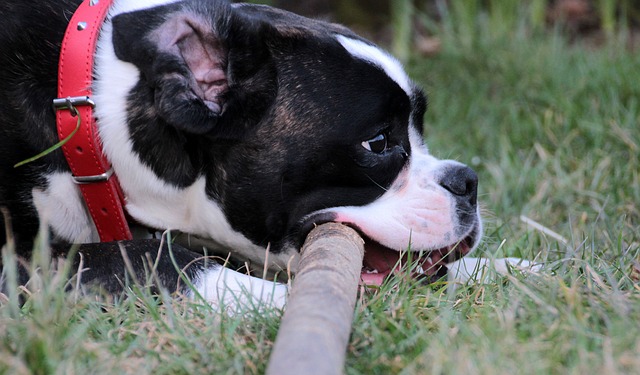 The adult boxer obtains total forty two teeth at its age of maturity. It should also be remembered, the boxer dog has also the instinct to clean its teeth by itself. However regular brushing the teeth is essential. If any boxer dog owner finds any abnormality in its teeth, then it is advised, proper dentist must check up your boxer’s mouth thoroughly. Daily dental care of your Boxer dog is also highly recommended. The negligence will result in the destructive tooth shape, disgusting appearance and yellowish in colour.
The adult boxer obtains total forty two teeth at its age of maturity. It should also be remembered, the boxer dog has also the instinct to clean its teeth by itself. However regular brushing the teeth is essential. If any boxer dog owner finds any abnormality in its teeth, then it is advised, proper dentist must check up your boxer’s mouth thoroughly. Daily dental care of your Boxer dog is also highly recommended. The negligence will result in the destructive tooth shape, disgusting appearance and yellowish in colour.
If you are so late, then be prepared, your boxer will go through the painful medication treatment and the spoiled one will be pulled out, which can also cause an infection. Some tooth-wipes are available in the market for cleaning the canine teeth of the boxer dog. Their usage is dependent upon if a boxer dog is reluctant to use a tooth brush. The boxer dog should also be taken before a professional veterinarian for the teeth check-up after every six months or at least after one year. This will dig out to the all the mess or cavities which is not normally possible to be removed after daily teeth cleaning.
Read more about Boxer teeth &Dental Care
2.Boxer Dog Exercise
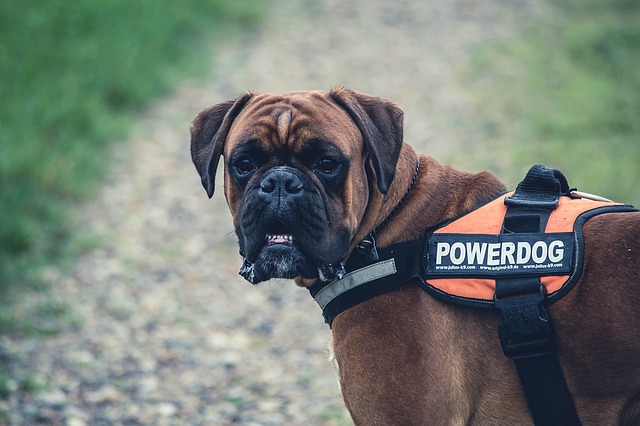 It is so critical and important for the boxer dog breed to have exercise and walks on regular basis. Boxer dogs are strongly-built and muscular animals that have immense energy in their bodies. They are world-wide popular for their strength and alertness. The Boxer dog exercise trainings should be started to a boxer dog from its puppy-hood and it should be continued for the rest of its life. Proper timing and schedule of the boxer dog exercise is of primary importance. The extreme weather conditions are not good for this particular dog breed for exercising.
It is so critical and important for the boxer dog breed to have exercise and walks on regular basis. Boxer dogs are strongly-built and muscular animals that have immense energy in their bodies. They are world-wide popular for their strength and alertness. The Boxer dog exercise trainings should be started to a boxer dog from its puppy-hood and it should be continued for the rest of its life. Proper timing and schedule of the boxer dog exercise is of primary importance. The extreme weather conditions are not good for this particular dog breed for exercising.
These are weather sensitive dogs. A boxer owner should try for 35-45 minutes’ walk with his/her boxer twice a day. For boxer puppies, one time daily is good enough. Walk is equally good for the natural uplifting of body movements but also for maintaining exquisite mental stimulation. Your boxer needs not only to get outdoors and exercise but also for getting familiar with the environment and also to socialize with people and dogs outside the home. An adult boxer will be happy enough to be getting involved in other games and types of exercises. It will keep it physically and mentally fit and helps him in controlling the weight.
Read more about Boxer Dog Exercise
3.Boxer Dog Eye Boogers
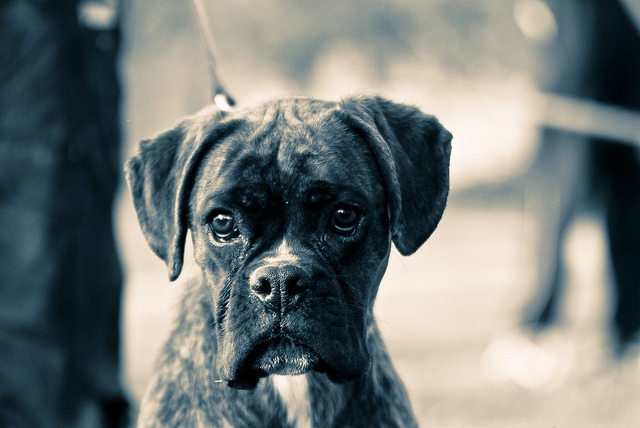 Boxer dog eye boogers are common eye problems which causes irritation and inflammation. The eyes of a boxer dog are very sensitive and delicate. They need extra care and protection especially in its puppy-hood. Normal guards, for example, eyelashes, tears, and eyelids are not generally enough to shield a puppy’s eyes from soil, tidy and at last disease. In simple words, in the eye boogers, a liquid is discharged from a boxer’s eyes which can be due to certain contaminations.
Boxer dog eye boogers are common eye problems which causes irritation and inflammation. The eyes of a boxer dog are very sensitive and delicate. They need extra care and protection especially in its puppy-hood. Normal guards, for example, eyelashes, tears, and eyelids are not generally enough to shield a puppy’s eyes from soil, tidy and at last disease. In simple words, in the eye boogers, a liquid is discharged from a boxer’s eyes which can be due to certain contaminations.
If the colours of eyes are white or milky-white, not so much reddish and if such effects are found on the corners, the situation can be normal and can be due to dirt or debris.
But if the eye-colouring is darker, dark-yellowish or dark-greenish, if blood-spotted badly, dried discharge on regular basis, odorous and if the nose is infected as well, it can be a serious threat to the eyes of the boxer and it should be medically examined by a reputable vet. If some serious trouble is diagnosed, then the instructions of the vet must be strictly followed and regular visits should be paid. It is important to clean the eye area of the boxer dog, especially during any infection.
Read more about Boxer dog eye boogers
4.Boxer Dog Grooming
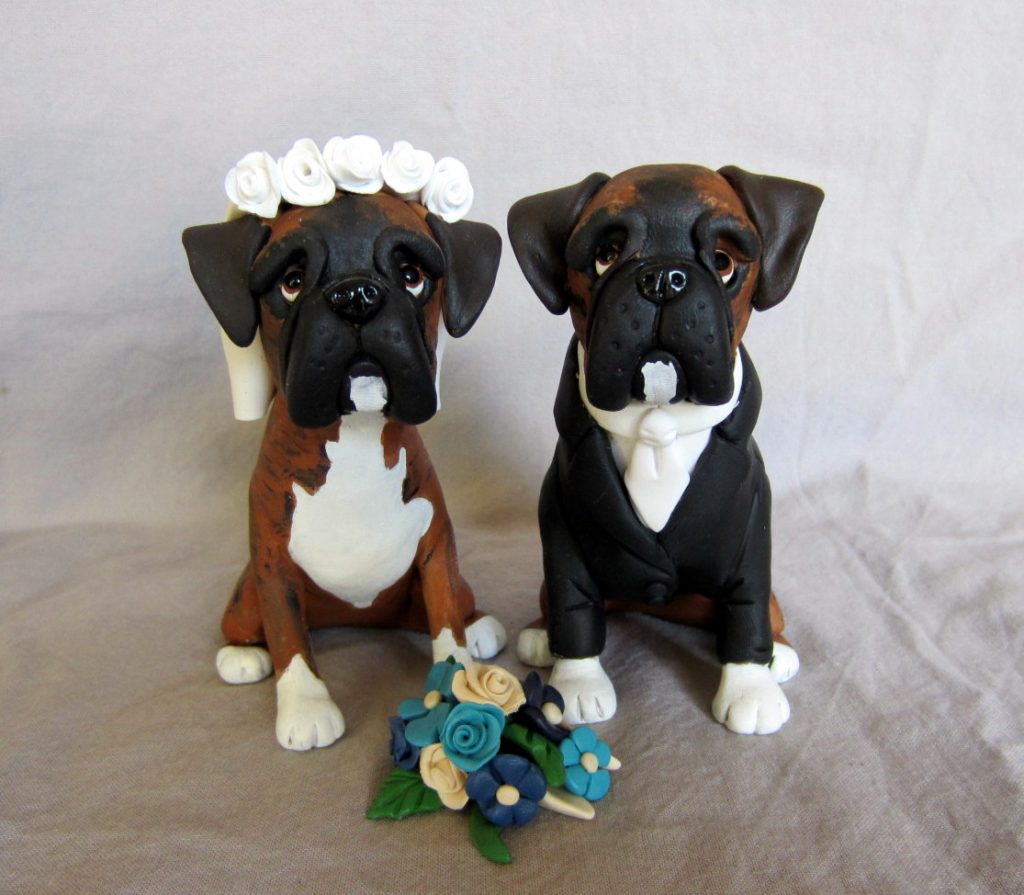 For best grooming of your boxer dog, you need to have proper knowledge and equipment as it is so significant for better up-bringing of your boxer dog. A ‘Grooming Kit’ can be useful which must include no-slip mat because it is considered to be the best for hair, nail clipping and cleaning of teeth and gum. Apart from the no-slip mat, Grooming Kit also contains different brushes, scissors or clippers, and combs. For boxer dog grooming at home, it is important that you must have a tub according to the size of your dog.
For best grooming of your boxer dog, you need to have proper knowledge and equipment as it is so significant for better up-bringing of your boxer dog. A ‘Grooming Kit’ can be useful which must include no-slip mat because it is considered to be the best for hair, nail clipping and cleaning of teeth and gum. Apart from the no-slip mat, Grooming Kit also contains different brushes, scissors or clippers, and combs. For boxer dog grooming at home, it is important that you must have a tub according to the size of your dog.
For bathing, many types of shampoo are available in the market, but canine shampoo is the best. You can use the sponge for lathering the face. The sponge is also best for dog’s tail cleaning. Once you properly lather your dog body and face, now it’s time to rinse it properly by using the towel.
The rinse process doesn’t take much time more than 3 minutes of rinsing. For hair-clipping purpose, the clippers should be lightly put into the boxer dog’s skin. While buying the pair of clippers, you have to concentrate on the quality. After clipping, you have to clean the ear. Nails trimming of your dog are also very important.
Read more about Boxer Dog Grooming
5.How to help a Boxer Dog ‘Live a Long Life’?
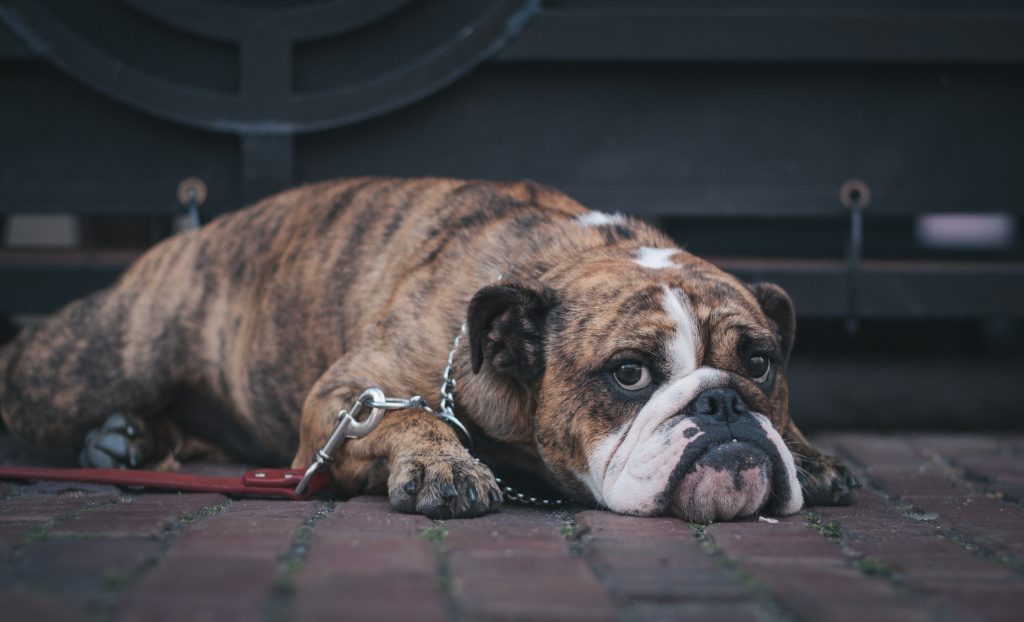 The cardiac issues and cancer are the most important and threatening to a boxer dog’s life. It is to be remembered, the average lifespan of a boxer dog is 10-12 years in comparison with other dog breeds. In addition to complete care, we can also take some other precautionary measures for the longevity or helping our boxer dogs to live a longer life. The boxer dog is an energetic and dynamic dog breed which requires suitable diet plan. Give him a disciplined food not only in its puppyhood but also in adult age.
The cardiac issues and cancer are the most important and threatening to a boxer dog’s life. It is to be remembered, the average lifespan of a boxer dog is 10-12 years in comparison with other dog breeds. In addition to complete care, we can also take some other precautionary measures for the longevity or helping our boxer dogs to live a longer life. The boxer dog is an energetic and dynamic dog breed which requires suitable diet plan. Give him a disciplined food not only in its puppyhood but also in adult age.
Vaccinations on time to time for your Boxer dog have a key role for the long life. It is needed on every stage of its life. If some disease is diagnosed, proper medical attention is required, the boxer owner must be very vigilant and proper vet must be consulted on time. Proper exercise should be a component part of its life. The duration of exercise and timing of the exercise should be kept in mind. Dental care of Boxer dog is of primary importance. Good boxer owners spend quality time with their boxers which keep them away from frustration and stress.
Read more about How to help a boxer dog live a long life?
6.Boxer Dog Shedding
 The boxer dog is considered as a moderate shedder dog breed and it is categorized in between the light and heavy shedding dog breeds. Generally, boxers don’t shed a lot and don’t require radical and continuous brushing. However, the hair growth and boxer dog shedding process may be different to some extent in boxer dog’s types depending upon the environment and their diet. Boxer dog shedding normally occurs after every six months during the fall and spring season.
The boxer dog is considered as a moderate shedder dog breed and it is categorized in between the light and heavy shedding dog breeds. Generally, boxers don’t shed a lot and don’t require radical and continuous brushing. However, the hair growth and boxer dog shedding process may be different to some extent in boxer dog’s types depending upon the environment and their diet. Boxer dog shedding normally occurs after every six months during the fall and spring season.
It is observed, when summer turns to winter and when winter changes to summer, boxers start shedding. It is observed, a boxer puppy sheds with comparatively smaller intervals up to one year and then the amount of shedding is decreased gradually and then it stables at the age of 2 years. The adult boxer dogs are generally known for non-shedders, as they don’t possess the longer and massive fur on their coats, their coats are looked smart and tight. For normal boxer dog shedding, effective grooming and proper brushing are important factors. If this rule is maintained, you’ll not get the annoyance, as your house will remain clean and without dog hair. Good breeders suggest, brushing all over the body of your boxer dog once a week is really important.
Read more about Boxer dog Shedding
7.Boxer Dog Summer Care
 In summer proper water intake is of primary importance for boxer. You should carefully check the drinking bowl of your dog on the regular basis. It is important that you shouldn’t give cold or frozen water to your dog. The water bowl of your dog should be filled with the water all times. For the summers short toenails are best option but don’t make it too short. As far as the fur is concerned, short version of it is best for the summers. Washing of the dog paws is also very important.
In summer proper water intake is of primary importance for boxer. You should carefully check the drinking bowl of your dog on the regular basis. It is important that you shouldn’t give cold or frozen water to your dog. The water bowl of your dog should be filled with the water all times. For the summers short toenails are best option but don’t make it too short. As far as the fur is concerned, short version of it is best for the summers. Washing of the dog paws is also very important.
This process stays away your boxer from consuming the road salt chemicals. In addition to this, you should keep your boxer in summer in the comfortable temperature place. If you are travelling long in summer then keep your dog inside the car in air-conditioning. Bath and swimming are the best way to keep your dog cool in the summer season. Swimming is also considered as phenomenal summer exercise and it is also a fun for the boxer dog. But if your boxer loves swimming, then you should keep the pool free from all sort of chemicals because it can be dangerous for its health.
Read more about Boxer Dog Summer Care
Boxer Dog Winter Care
 Being a weather sensitive dog breed, boxer also needs protection from harsh cold weather in winters. Stop shaving as hair provide natural protection against icy cold weather. Better to buy him a sweater which saves him from the chillness. Do not leave your dog outside for long because outside chillness can make him sick. In the winter, it is also important like summer that you wash the feet of your dog after the outdoor activity. If you live in a snowy area then you should trim the paws hair, so that snow doesn’t accumulate in between the toes. Additionally, you should brush your dog hair regularly and remove any mats or tangles stuck in there.
Being a weather sensitive dog breed, boxer also needs protection from harsh cold weather in winters. Stop shaving as hair provide natural protection against icy cold weather. Better to buy him a sweater which saves him from the chillness. Do not leave your dog outside for long because outside chillness can make him sick. In the winter, it is also important like summer that you wash the feet of your dog after the outdoor activity. If you live in a snowy area then you should trim the paws hair, so that snow doesn’t accumulate in between the toes. Additionally, you should brush your dog hair regularly and remove any mats or tangles stuck in there.
Vet appointments on regular basis in winter play an important role. When your boxer is exposed to coldness, it can become feeling down and cold. During the cold days, if ice is melting, walking over it can be toxic to your dog. Also take care of dryness and it has put bad impact on the skin then proper treatment should be started. In the winters it is very common that your dog becomes the victim of ticks and fleas, so you should take care of this factor as well.
Read more about Boxer dog winter care
Boxer Dog Health problems
1.Boxer Dog Allergies
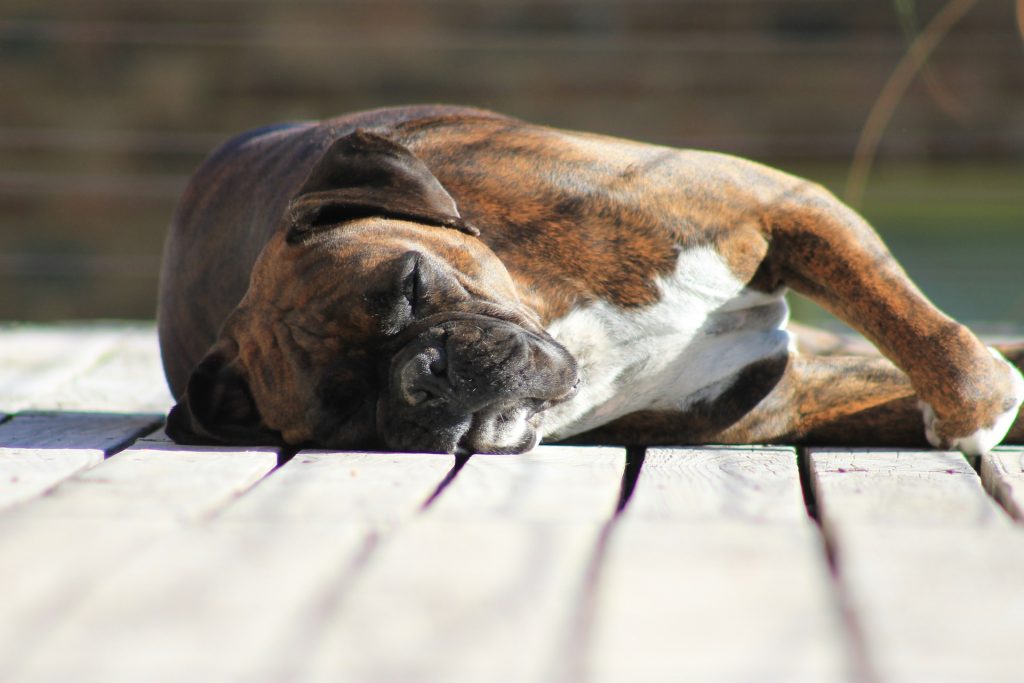 Some kind of allergies are also commonly observed in the boxer dog breed, with some of which can put minimal effects while some of them can be really fatal. As a result of allergies, the tissues, skin and fur can become infected and troublesome. And if not treated in time, these can lead to other severe types of circumstances. These problems can be prevented if authentic guidelines are followed by a boxer dog owner.
Some kind of allergies are also commonly observed in the boxer dog breed, with some of which can put minimal effects while some of them can be really fatal. As a result of allergies, the tissues, skin and fur can become infected and troublesome. And if not treated in time, these can lead to other severe types of circumstances. These problems can be prevented if authentic guidelines are followed by a boxer dog owner.
When it comes to the external effects, the reaction can be observed on skin which can be from seeable irritation to distressing situations. Some allergies are also caused by fleas. The treatment can be started after medical consultation with the vet. Some cleaning chemicals can also react in form of certain allergies in a boxer dog. There can be some internal types of allergies which can come out in form of indigestion and vomiting or diarrhea.
In most of the cases, the reason can be for the ingestion of some harmful object. Sometimes, a boxer dog can also be infected with some allergy due to some unsuitable food elements mixed in its diet. Removal of such elements can prevent the boxer dog from such allergies.
Read more about Boxer Dog Allergies
2.Boxer dog bad breath
 Bad breathing by a boxer dog can be the indicator of certain medical problems, for example, dental or oral medical issues. Wiping boxer dog’s gums with a perfect, dry fabric in the wake of brushing the teeth can be helpful in evacuating any kind of plaque on the gum line. Some kind of changes brought in the nourishment and diet plan might also affect in shape of bad-breathing by a boxer dog. Your boxer dog can get bacterial and viral diseases, much the same as we can.
Bad breathing by a boxer dog can be the indicator of certain medical problems, for example, dental or oral medical issues. Wiping boxer dog’s gums with a perfect, dry fabric in the wake of brushing the teeth can be helpful in evacuating any kind of plaque on the gum line. Some kind of changes brought in the nourishment and diet plan might also affect in shape of bad-breathing by a boxer dog. Your boxer dog can get bacterial and viral diseases, much the same as we can.
If you start using some drops of lemon squeeze in your dog it can put better results. Provide your boxer with toys and treats that improve biting, this can evacuate the plaque and it is also useful for your dog to learn biting. Change the brand of dog nourishment and attempt a hypoallergenic mark. Your boxer’s bad breath can also be due to some issued being developed in its mouth, stomach or lungs. A proper medical analysis will determine a real cause. Gingivitis can also cause bad breath and it should be investigated if it is due to the pooch’s gums. Boxer dog with kidney issues are also known to have truly awful breath.
Read more about Boxer bad breath
3.Boxer Dog Gas
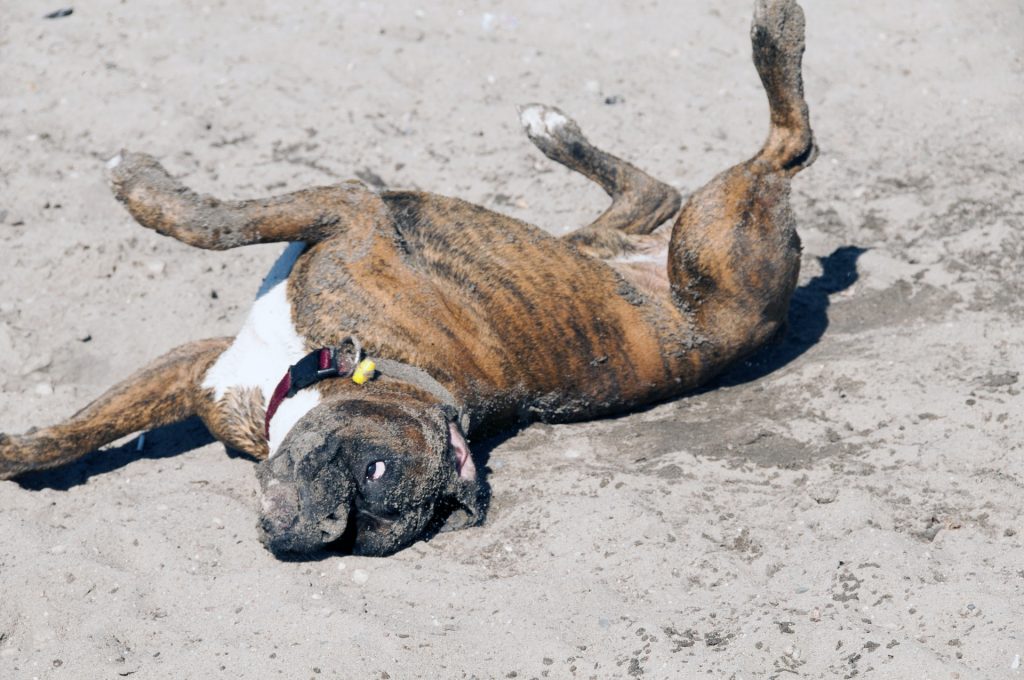 Boxer dogs can get gastric trouble number of reasons. Most boxer puppies will have farted now and again, brought on by the breakdown of sustenance by microscopic organisms in their stomachs. When they discharge gasses, they have to go to a certain place and this way indicates you get the chance to notice it. If a boxer pup is suffering from gas, it is undoubtedly experiencing dietary lopsided characteristics that you can manage effectively.
Boxer dogs can get gastric trouble number of reasons. Most boxer puppies will have farted now and again, brought on by the breakdown of sustenance by microscopic organisms in their stomachs. When they discharge gasses, they have to go to a certain place and this way indicates you get the chance to notice it. If a boxer pup is suffering from gas, it is undoubtedly experiencing dietary lopsided characteristics that you can manage effectively.
It will simply take a tiny bit of research into what sort of eating regimen your dog will do best with and some solid limits in the house about what the puppy is not permitted to eat. Similarly if your adult boxer is having has a gas issue, it’s a great opportunity for you to reassess his eating routine and how he gets nourished. Stop filling the dog table sustenance quickly. It’s not cool to give your canine a taste of brew or beverage. No canine treats unless they are low in fat and of high caliber. Give your boxer some papaya juice off and on. Give them yogurt until the twist fades away. Cooked plain white rice or pasta with some plain bubbled chicken can give alleviation from gastrointestinal bombshell.
Read more about Boxer Dog Gas
4.Boxer Puppy and Dog Whining Issues
A boxer lover brings a cute boxer puppy at home with lots of passions and affection. But the boxer puppy can start whining and it can last for many hours, days or even in some cases for weeks. The boxer pup will whine as it was separated from its pack or littermates or from the previous owner for the first time. You just need to calm down and tolerate this situation. Soon, your boxer pup will get attached and get familiar with the newer environment. If your box puppy is starving for some food and it is not being met with its full water drinking needs, then it will start whining too. Extra heat or cold both will add to the agonizing behavior of your boxer pup and it will start whining.
Sometimes there can be some health issues being faced by your boxer puppy, it will start whining. The adult boxer dog can also whine due to the fear of separation anxiety, some disease factors, seeking the attention or care or wanting of something. Furthermore, a boxer dog should not b crated for longer spans. If kept in such an environment, it will also start whining.
Read more about Boxer puppy and Dog whining issues
5.Cancer in Boxer Dogs
 Cancer is the root cause for the shorter life of boxer dog. It is estimated that half of the dog population over 10 years in the world suffer from cancer in that stage of their lives. Normally, the dogs are observed with malignant lymphoma (a tumor of the lymph nodes), mast cell tumors (skin cancer), mammary gland tumors, breast cancer, soft tissue sarcoma and bone cancer effects. As far as the causes of cancer in boxer dog are concerned, the style of living, the environmental conditions in which the boxer dog is passing its life and even it can also be due to the genes transferred in your boxer dog from its predecessors.
Cancer is the root cause for the shorter life of boxer dog. It is estimated that half of the dog population over 10 years in the world suffer from cancer in that stage of their lives. Normally, the dogs are observed with malignant lymphoma (a tumor of the lymph nodes), mast cell tumors (skin cancer), mammary gland tumors, breast cancer, soft tissue sarcoma and bone cancer effects. As far as the causes of cancer in boxer dog are concerned, the style of living, the environmental conditions in which the boxer dog is passing its life and even it can also be due to the genes transferred in your boxer dog from its predecessors.
There can be some other reasons, as sometimes there can be sudden and unpredictable metamorphosis of cells in the body of boxer dog and it can be sometimes unidentified. Sometimes if some boxer dog has such types of sores or injuries which are not healing in time, these can consequently make some infection and even those can also lead to the birth of cancer in its body. The treatment of cancer in an infected boxer dog is just like as it is applied on humans and its ways can differentiate depending on its forms.
Read more About Boxer dog cancer
6.Boxer dog stomach issue
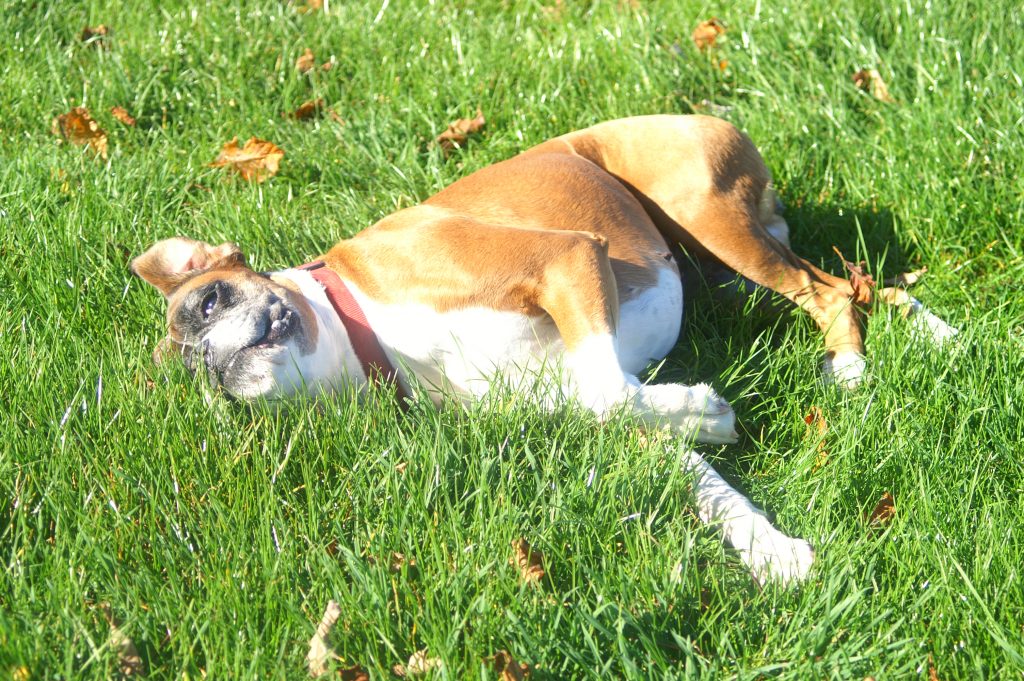 The upset stomach of the boxer dog can happen due to the several reasons from fast eating to the blockage of intestines. To resolve the stomach issue you have to first understand the main cause of it, and second, you have to spot-on the eating habits of your dog straightaway. It may also happen because of the food allergy or due to the food eating, too fast eating and too much eating. Stress also makes your boxer dog sensitive and as a result, it gets sick. Sometimes we think that the stomach upset issue of our dog is not that much serious, but in reality, it is life threatening.
The upset stomach of the boxer dog can happen due to the several reasons from fast eating to the blockage of intestines. To resolve the stomach issue you have to first understand the main cause of it, and second, you have to spot-on the eating habits of your dog straightaway. It may also happen because of the food allergy or due to the food eating, too fast eating and too much eating. Stress also makes your boxer dog sensitive and as a result, it gets sick. Sometimes we think that the stomach upset issue of our dog is not that much serious, but in reality, it is life threatening.
Toxic food is also the main cause of Boxer dog upset stomach, and you have to visit the vet for proper treatment. You shouldn’t give baby foods to them. Baby foods are not bad in general, but the presence of onion powder makes it unhealthy for your dog. For home treatment, you should give some simple and less heavy food to your dog such as white rice with boiled chicken. However it is important to monitor the situation to check that the situation isn’t getting worse. And if continues, then take it to the vet for diagnosis and medication.
Read more About Boxer dog Stomach issue
7.Boxer dog bloating issue
 Torsion and Gastric troubles also referred as Bloating issues. In this situation, the stomach of your boxer dog gets swelled, and as a result, it becomes the main cause of death. This situation happens when the excessive amount of air or gas grows in the dog’s stomach, or he takes so much food or fluid. As the stomach swells, it blocks the blood flow level and takes in the air, food, and water.
Torsion and Gastric troubles also referred as Bloating issues. In this situation, the stomach of your boxer dog gets swelled, and as a result, it becomes the main cause of death. This situation happens when the excessive amount of air or gas grows in the dog’s stomach, or he takes so much food or fluid. As the stomach swells, it blocks the blood flow level and takes in the air, food, and water.
During the bloating issue, the affected boxer dog wants to do vomit to get rid of the pressure, but the abdomen veins get stuffy and ultimately leading to low blood pressure and damages the internal organs. There are certain preventive measures through which, you can resolve the boxer dog bloating issue immediately. Otherwise, urgent medical treatment becomes necessary.
In fact, Bloating is a medical emergency. If your boxer is facing the high bloating risk issue, then make sure that your veterinarian is capable enough to treat the bloating issue and if not, then you should search for some nearest veterinary. The longer you will keep the bloating issue of your dog untreated; there would be dangerous consequences and difficulty to survive for your boxer dog.
Read more about Boxer dog bloating issue
8.Skin problems in boxer dog
 Boxer dog breed can be prone to certain skin problems which can badly affect its. Demodectic mange is caused by a mite which is called ‘demodectic mite’ that is found on the bodies of dogs. A histiocytoma is a kind of skin tumour which is developed in Langerhans cells which play a vital role in protecting the immunity system of the tissues related to the outer parts like nose, stomach and lungs particularly to the skin’s surface.
Boxer dog breed can be prone to certain skin problems which can badly affect its. Demodectic mange is caused by a mite which is called ‘demodectic mite’ that is found on the bodies of dogs. A histiocytoma is a kind of skin tumour which is developed in Langerhans cells which play a vital role in protecting the immunity system of the tissues related to the outer parts like nose, stomach and lungs particularly to the skin’s surface.
Skin itching causes a lot of irritation and soreness in a boxer dog and it is also a predominant skin-related issue which results in feeble type of skin of a boxer dog breed. Hay fever which is a form of allergy and is known to be caused by pollen or dust particles; it is transmitted in the nose and eyes especially due to air, is also a culprit for bringing a reaction in boxer dogs.
Seasonal effects like dryness particularly damage the skins of sensitive boxer dogs. If your boxer dog’s vet has diagnosed some serious types of skin problems like mange, mites or allergic infections, then the medication as recommended by him must be applied on the affected boxer dog for proper treatment.
Read more about Skin Problems in boxer Dog
9.Boxer Dog Eye Disease
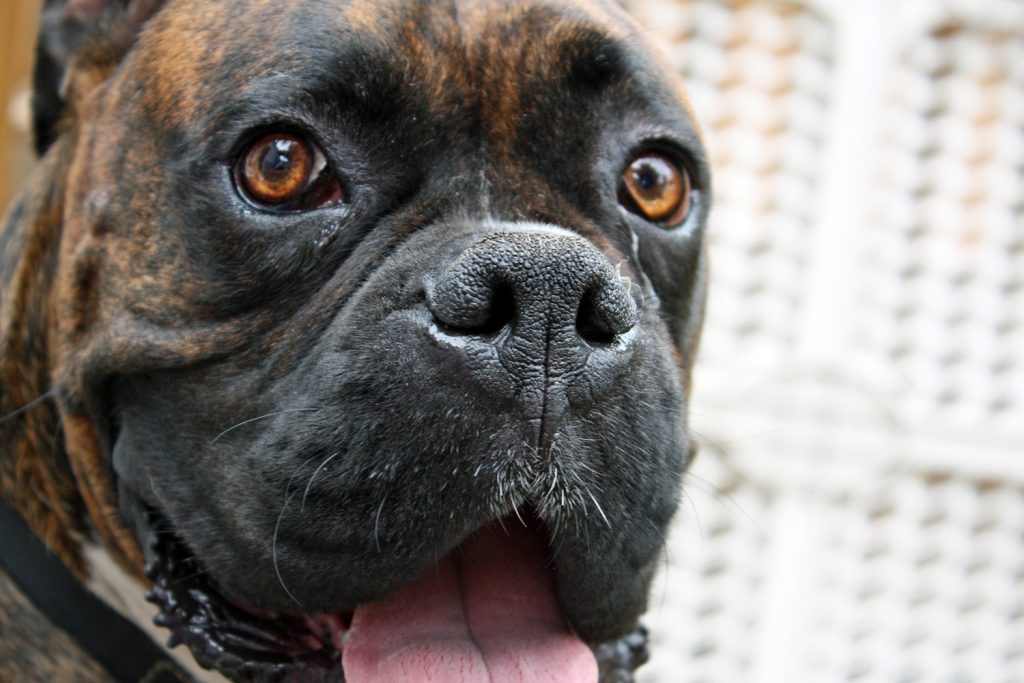 There are many eye diseases that might affect a boxer dog and most of those are genetically transmitted. ‘Progressive Retinal Atrophy (PRA)’, one of the most serious eye diseases, which is normally caused by the declining of retinal cells. The main cause of ‘Entropion’ is excessive skin around the dog’s eyes, which makes it difficult for the dog to roll the eyes inward.
There are many eye diseases that might affect a boxer dog and most of those are genetically transmitted. ‘Progressive Retinal Atrophy (PRA)’, one of the most serious eye diseases, which is normally caused by the declining of retinal cells. The main cause of ‘Entropion’ is excessive skin around the dog’s eyes, which makes it difficult for the dog to roll the eyes inward.
In case of ‘Ectropion’ a boxer loses his facial skin too much, and then it became the main reasons of sagging eyelids. ‘Corneal Scratches and Ulcers’ are painful for your boxer dog, but it is normally transmitted genetically in your dog. The main cause of this Disease is, dust particles and grass seeds. ‘Cherry eye’ can be treated either by surgical removal of the gland or occasionally by medication.
A ‘Cataract’ is opacity within the lens, which lies directly behind the iris and which can eventually cause blindness. In case of ‘Glaucoma’, the fluid pressure within the eyeball increases and brings about discomfort and blindness. ‘Scleritis’ occurs due to sclera inflammation. ‘Pigmentary Keratitis (PK)’ is normally caused by the annexation of blood vessels. It is normally linked to the genetics in boxer breed. In all such cases you must bring your boxer to the veterinary without delay.
Read more about Boxer Dog eye Disease
10.Boxer Dog Ear Infections
 Normal types of ear infections in a boxer dog can be treated at home with cleaning or some medication. But if the ears of your dog are packed with the foul odor, and he rubs his ear rottenly, then you should take him to vet. Ear infections are of many types, so before treatment, you should know that which type of infection your dog is suffering from?
Normal types of ear infections in a boxer dog can be treated at home with cleaning or some medication. But if the ears of your dog are packed with the foul odor, and he rubs his ear rottenly, then you should take him to vet. Ear infections are of many types, so before treatment, you should know that which type of infection your dog is suffering from?
There are some natural remedial measures which can be useful in getting rid of ear infections. It is important to clean your boxer’s ears to prevent the infection the wiping off the bacteria becomes critical in case of an infection. Veterinarian ear care revolves around plucking all the excess hair from the ear and then rinsing out the wax.
In addition to this, the vey may also suggest certain medications and doses, which should be strictly followed. Anti-fungal medication to overcome the boxer dog’s ear infections can also be useful. Some dog’s vets also recommend using the antibiotics in the severe bacterial ear infection. It is also observed, underlying allergy can also be the main cause of boxer dog ear infections. After treatment, it is very important to visit your vet to confirm, if infection is really eliminated or not.
Read more about Boxer dog ear Infections
11.Boxer dog dry noses
 Lateral gland fluids in a dog’s nose stretch the nostrils surfaces and make them moist and shiny. But mostly, the nose stays dry because your dog is always licking it. Moisture on the dog nose normally comes from the area that is being licked. The more your dog licks that area, the more moisture will be appearing on its nose. When you feel that dryness on the nose of your boxer is occurring, you should give him more water. Dry nose is the result of dehydration, so to re-hydrate the body of your dog; you should give him more water.
Lateral gland fluids in a dog’s nose stretch the nostrils surfaces and make them moist and shiny. But mostly, the nose stays dry because your dog is always licking it. Moisture on the dog nose normally comes from the area that is being licked. The more your dog licks that area, the more moisture will be appearing on its nose. When you feel that dryness on the nose of your boxer is occurring, you should give him more water. Dry nose is the result of dehydration, so to re-hydrate the body of your dog; you should give him more water.
If your dog often feels this problem after waking up, then you should open the window of its room, but just a bit. Providing humidifier is also very best thing to overcome the issue of dry nose of dog.
This device is not only best for restoring the humidity, but also the moist of indoor air. If the air of your house is lean towards dryness, then you should go for the room mist. It doesn’t only increase the moist level of indoor air, but also purifies from the germ and bacteria. Always give preference to the organic air mist.
Read more about Boxer dog dry noses
12.Hip Dysplasia in Boxer Dogs
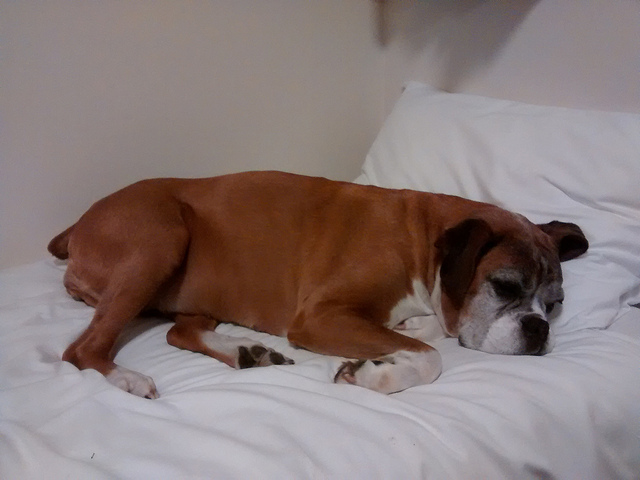 Hip Dysplasia in boxers is also considered as a genetic disease, although it can be also developed due to some harsh environmental conditions. When the ball and socket joint in a dog are impaired, it is affected with Hip Dysplasia. It weakens the both sections held firmly by the ligaments and resultantly, the ball appears out of its genuine place in the socket. Ultimately if it is continued, the boxer dog experiences severe types of worst health conditions.
Hip Dysplasia in boxers is also considered as a genetic disease, although it can be also developed due to some harsh environmental conditions. When the ball and socket joint in a dog are impaired, it is affected with Hip Dysplasia. It weakens the both sections held firmly by the ligaments and resultantly, the ball appears out of its genuine place in the socket. Ultimately if it is continued, the boxer dog experiences severe types of worst health conditions.
If someone is interested in the breeding of boxer dog, it is recommended for the proper screening of the each of the pair. Overweighting is also a major factor that causes hip dysplasia in a boxer dog. Hip dysplasia is started with proper medication in which normally Corticosteroids are given to a boxer dog to minimize the joint’s swelling
. Some forms of medication are also suggested to lower down the swelling and pain level by the vet. If the situation is not better and problem is continuing, then pertinent surgical methods are used. After the surgery, your boxer dog might also be suggested for intake of some pain killers and certain antibiotics. Hip Dysplasia slowly starts to appear and if it is not treated in time, it ruins all the functions of the hip joints consequently.
Read more about Hip Dysplasia in boxer dog
13.Boxer dog Colitis
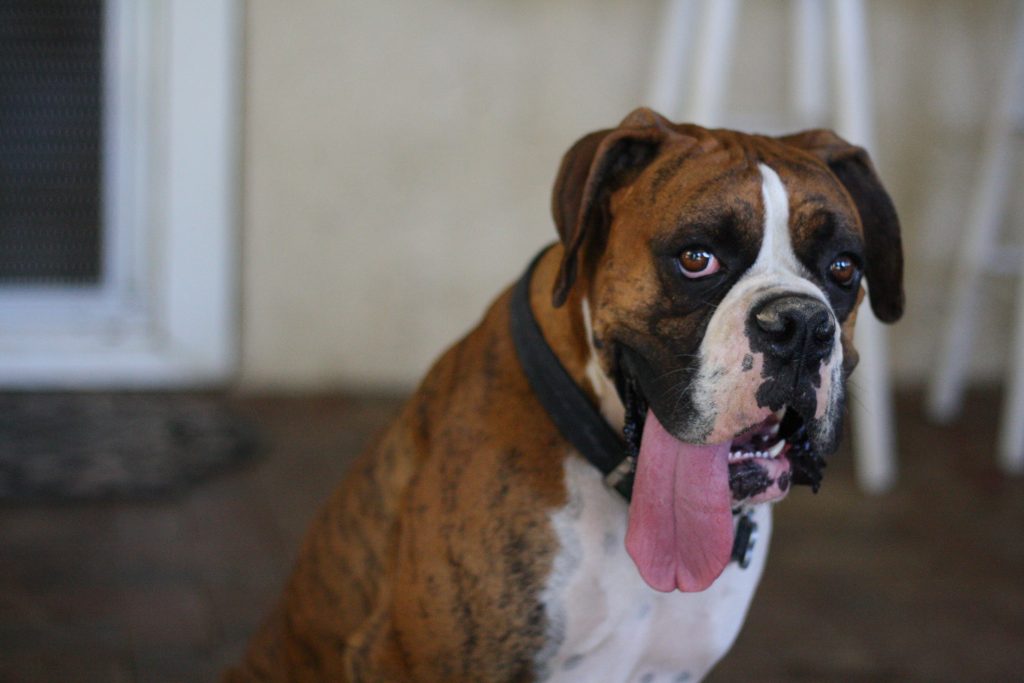 If your boxer dog is suffering from Colitis disease, there can be some alarming situations which should be noticed by the boxer dog owner in time. Colitis is a disease in which the large intestine or colon is infected with irritability and as a result of which, it usually causes diarrhea.
If your boxer dog is suffering from Colitis disease, there can be some alarming situations which should be noticed by the boxer dog owner in time. Colitis is a disease in which the large intestine or colon is infected with irritability and as a result of which, it usually causes diarrhea.
It is extremely painful, agonizing and unpleasant situation for a boxer dog, when it is suffering from Colitis. Gradually, boxer dog will lose its weight. The ribs will become more and more prominent day by day.
Some boxer dogs might have gastric issues and also vomiting will be happening off and on. If your boxer dog is suffering from un-expected Colitis, it could be due to un-bearable stress and mental disgust with your boxer dog.
It is recommended to take several types of tests and complete medical diagnosis. A perfect vet will also keep a keen eye on the food count of such boxer dog and also check up the discharged material. X-rays can also be done. When Colitis becomes more serious trouble, it also causes the gradual destruction of the immunity system of the boxer dog and it usually becomes the forms of histiocytic colitis or plasmocytic-lymphocytic colitis.
Read more about Boxer dog colitis
14.Boxer dog Cardiomyopathy
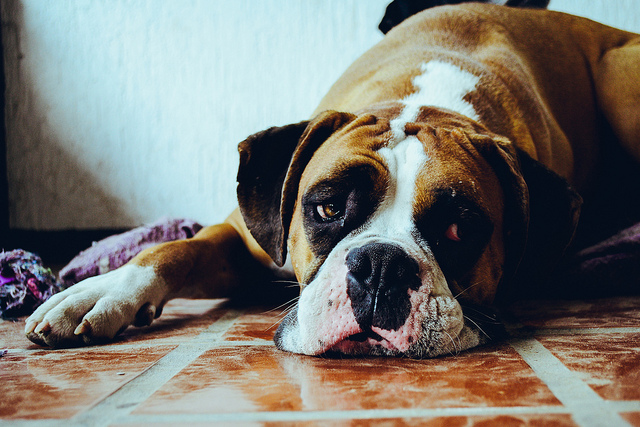 Boxer dog cardiomyopathy’ denotes; an unexpected and unforeseen death due to the failure of cardiac functioning. Cardiomyopathy have a tendency to occur in the boxer puppies aging between 1.5 – 2.5 years, however some very young boxer puppies are also recorded to be affected by Cardiomyopathy.
Boxer dog cardiomyopathy’ denotes; an unexpected and unforeseen death due to the failure of cardiac functioning. Cardiomyopathy have a tendency to occur in the boxer puppies aging between 1.5 – 2.5 years, however some very young boxer puppies are also recorded to be affected by Cardiomyopathy.
As the unusual and irregular heart beat is considered as the primary reason of Boxer cardiomyopathy, it must be noted; sometimes such problem might also be due to caustic infections or some types of cancer as well. When a routine examination of boxer dog is done, a variable, irregular or inconsistent heart beat might be observed. This might result in the fainted appearance of a boxer dog. Boxer cardiomyopathy can also be inherited from an affected parent by a boxer dog. Coughing can be started by an affected boxer dog at this stage which should be noticed.
Some kind of abnormal and faster breathing has also a correlation with Boxer cardiomyopathy. The best way is to have a regular check up and examination by a vet who can diagnose Boxer cardiomyopathy. If Boxer cardiomyopathy is not reached to an alarming stage in an affected boxer dog, the applying of anti-arrhythmic medication can be fruitful.
Read more about Boxer dog Cardiomyopathy
15.Boxer Dog Ear Mites
 ‘Ear mite’ which is known as ‘Otodectes cynotis’ is in majority of the cases the main culprit of ear mite infections in boxer dogs. Such mites or bugs are developed due to the subsistence of oil or wax around or inside the ears of a dog. To safeguard your boxer dog, it is suggested to remove these tiny but noxious creatures as soon as there is a doubt of their presence in the ear area. Sometimes they are found around the neckline, chest parts or even they can populate themselves in the legs and tails area of a boxer dog as well.
‘Ear mite’ which is known as ‘Otodectes cynotis’ is in majority of the cases the main culprit of ear mite infections in boxer dogs. Such mites or bugs are developed due to the subsistence of oil or wax around or inside the ears of a dog. To safeguard your boxer dog, it is suggested to remove these tiny but noxious creatures as soon as there is a doubt of their presence in the ear area. Sometimes they are found around the neckline, chest parts or even they can populate themselves in the legs and tails area of a boxer dog as well.
If your boxer dog has started tangling or scratching its head. It can be due to the presence of ear mites. In some cases, the unusual swelling or redness can also appear on the ears of a boxer dog which becomes prominent. It might be due to ear mites.
The most common reason for getting the ear mites by your boxer dog is due to the transmission from other canine companions. A qualified and reputed vet should be consulted in much trouble, who will examine the ear canal carefully with the help of an otoscope.
Read more about Boxer Dog Ear Mites
16.Boxer dog mast cell tumors and surgery
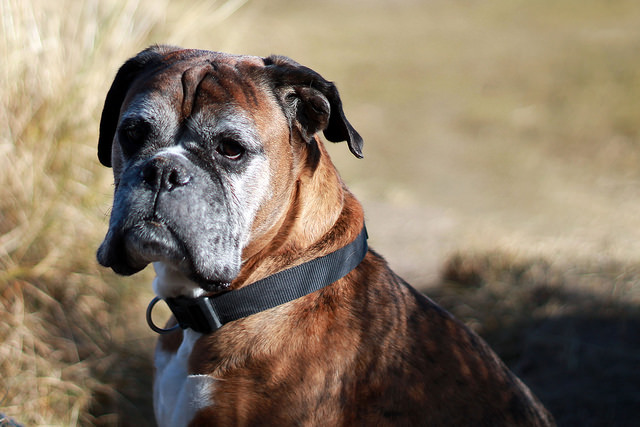 Mast cells in a boxer dog consist of several types of enzymes which work to break proteins and also work as defense shield against the harmful invaders to the body. They are also known to perform functions for the composition of blood vessels.
Mast cells in a boxer dog consist of several types of enzymes which work to break proteins and also work as defense shield against the harmful invaders to the body. They are also known to perform functions for the composition of blood vessels.
Mast cell tumours are the result of the complications and mess being generated by the enzymes which are found in the mast cells. It all happens when the mast cells become in so abundance and their number reaches to abnormality, ultimately they cause the appearance of a tumor on a boxer dog’s body.
Boxer dog breed is one of the most prone to the mast cell tumours which can be developed in all ages of a boxer dog. A good vet always learns the ferocity of metastasis by staging the mast cell tumours. If tumours are in numerous numbers, some tmours can be eradicated through surgery while some can be left for further observation. Sometimes it is not possible for a vet surgeon to execute the surgical removal of mast cell tumour then radiation can also be a viable option. The radiation therapy is deemed favorable which can eliminate the chances of reappearance of such tumours.
Read more about Boxer dog mast cell tumors and surgery
17.Boxer Dog Arthritis
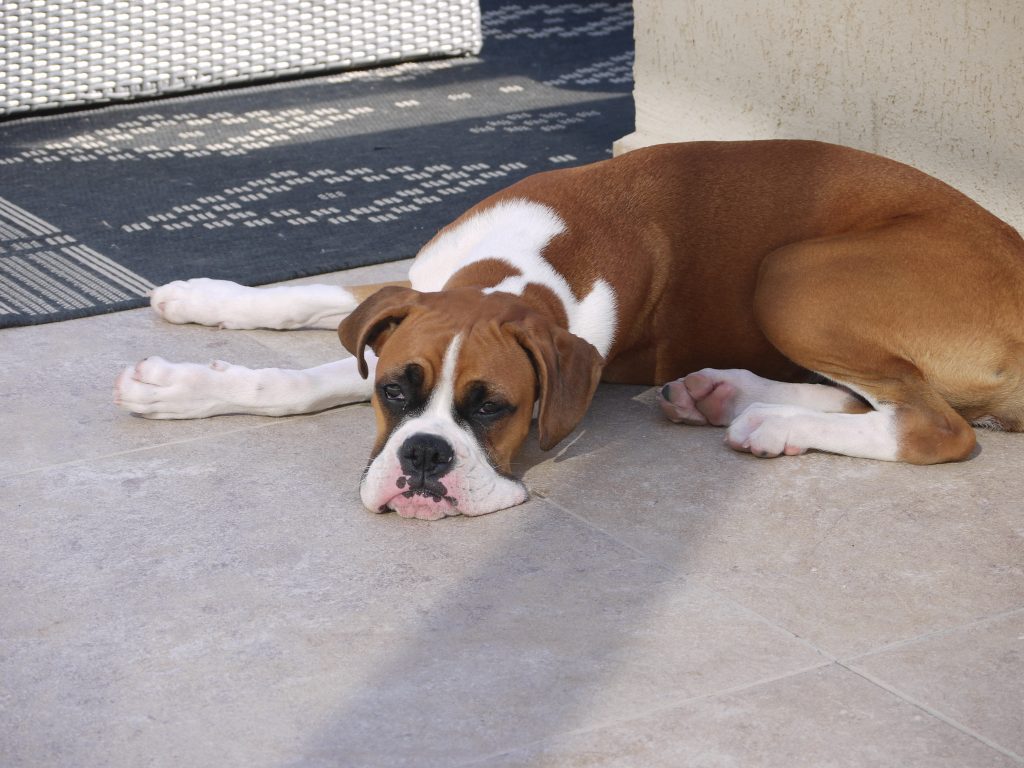 Arthritis is also a common disease in boxer dog in which the joints of a boxer dog become swollen. And as a result of which some unwanted liquid starts converging in and around the joints and the bony process becomes decayed. Ultimately all smooth functioning of boxer dog’s joints become unsettled and complicated and a continuous spiral of pain, lameness and muscle atrophy initiate consequently. Boxer Dog Arthritis can be due to some injury mostly related to ligaments of a boxer dog. Or, if your boxer dog is already suffering from hip dysplasia, there are more chances of Boxer Dog Arthritis.
Arthritis is also a common disease in boxer dog in which the joints of a boxer dog become swollen. And as a result of which some unwanted liquid starts converging in and around the joints and the bony process becomes decayed. Ultimately all smooth functioning of boxer dog’s joints become unsettled and complicated and a continuous spiral of pain, lameness and muscle atrophy initiate consequently. Boxer Dog Arthritis can be due to some injury mostly related to ligaments of a boxer dog. Or, if your boxer dog is already suffering from hip dysplasia, there are more chances of Boxer Dog Arthritis.
Chubbiness and fatness can be a main reason for the development of Boxer Dog Arthritis as extra bony material is set up around the joint. If your boxer dog is behaving in lethargic, dull and tiring manner and it is avoiding going outdoors for walks and exercises; these all can be the signs of development of Boxer Dog Arthritis. With the rapid development in the dog medical science, hundreds of medications including anti-inflammatory drugs are available to control Boxer Dog Arthritis. There is also availability of many kinds of herbal treatments. Instead, it is always better to seek the advice of your dog’s veterinarian.
Read more about Boxer Dog Arthritis.
18.Lymphoma in boxer dog
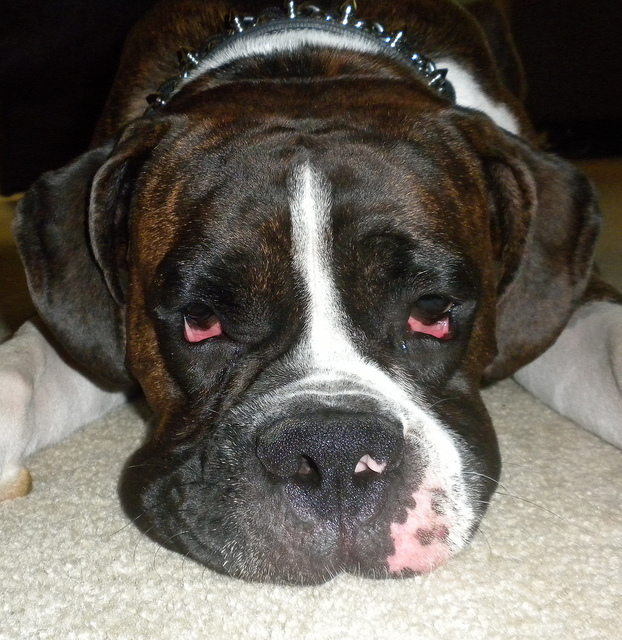 Lymphoma in boxer dog breed appears, when its white blood cells which are known as lymphocytes lose their main function, i-e to shield the boxer dog’s body from fatal infections and they stop to generate the anti-infectious substances. Such lymphocytes become cancerous and cause lymphoma in a boxer dog. For a boxer dog owner, this fact is to be kept in mind; the boxer dog breed is more prone to lymphoma than other dog breeds in the world. If the size of such lymph node seems bigger than the normality then it can be a clear sign of lymphoma.
Lymphoma in boxer dog breed appears, when its white blood cells which are known as lymphocytes lose their main function, i-e to shield the boxer dog’s body from fatal infections and they stop to generate the anti-infectious substances. Such lymphocytes become cancerous and cause lymphoma in a boxer dog. For a boxer dog owner, this fact is to be kept in mind; the boxer dog breed is more prone to lymphoma than other dog breeds in the world. If the size of such lymph node seems bigger than the normality then it can be a clear sign of lymphoma.
Such lymph nodes cannot be painful or irritant to a boxer dog generally, but if touched, they will seem a little bouncy and stiffened. The abnormal behavior while the food in-take by a boxer dog can also be a sign of lymphoma.
In its treatment, the vet conducts some diagnostic tests after medical and physical examination. The vet can further use the fine-needle aspiration method of an enlarged lymph node to determine lymphoma. Some vets will also suggest the systematic chemotherapy, in which the doses of numerous types of chemotherapy drugs can be given on a same time.
Read more about Lymphoma in boxer dog
19.Seizures in boxer dog
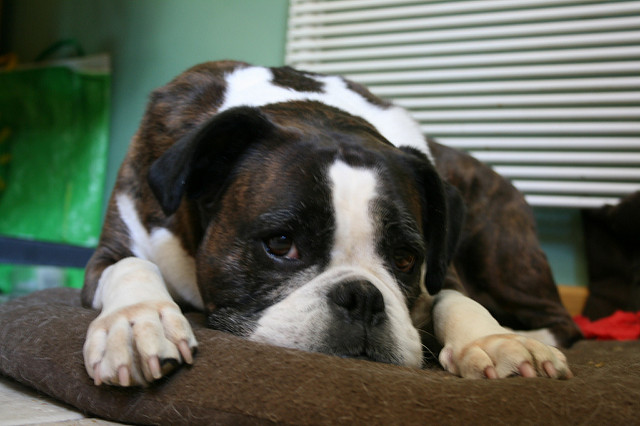 A seizures disorder in a boxer dog might outcome as shattering of body, jerking and jiggling of muscles, loss of sensibility, salivating and chewing its tongue or bubbles coming from its mouth. A boxer dog if caught with seizures can fall to its side and start boating movements by its legs. There can be several reasons of seizures in a boxer dog which can cause this typical state of mental disease. Epilepsy is also certain kind of neurological disorder that causes a boxer dog to react in shape of abrupt and undisciplined sort of seizures.
A seizures disorder in a boxer dog might outcome as shattering of body, jerking and jiggling of muscles, loss of sensibility, salivating and chewing its tongue or bubbles coming from its mouth. A boxer dog if caught with seizures can fall to its side and start boating movements by its legs. There can be several reasons of seizures in a boxer dog which can cause this typical state of mental disease. Epilepsy is also certain kind of neurological disorder that causes a boxer dog to react in shape of abrupt and undisciplined sort of seizures.
Seizures are also sometimes the results of the existence of brain tumours in a boxer dog. Degenerative myelopathy can also cause seizures especially in the old-aged boxer dogs which is actually a progressive disease of the spinal cord. There are many types of medications available in the market these days for the treatment of seizures in a boxer dog. Bur 100% cure with medications is still not possible. There is a continuous struggle carried on for the determination of the root causes of seizures in boxer dog. With a balanced food and keeping a constant check on the seizure suspect boxer, the dangers of this unpredictable disease can be minimized.
Read more about seizures in boxer dog
20.Hypothyroidism in Boxer Dogs-Thyroid Problems
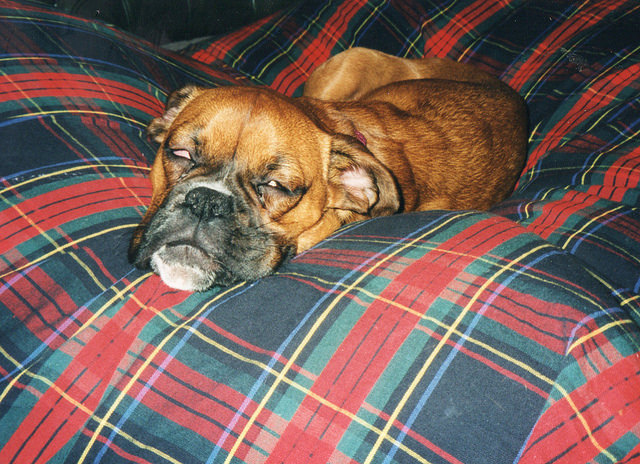 Boxer dog possesses the thyroid glands on the both sides of its necks and if these glands are disordered then the boxer dog suffers from many types of diseases in which Hypothyroidism is the most prominent. Hypothyroidism and thyroid problem can be genetically transmitted after breeding to the young ones as well. This disease is not considered as deadly and so potentially fatal but still it can badly influence the healthy lifestyle of a boxer dog. The hypothyroidism and thyroids may be of three types including juvenile onset, secondary hypothyroidism and the primary hypothyroidism.
Boxer dog possesses the thyroid glands on the both sides of its necks and if these glands are disordered then the boxer dog suffers from many types of diseases in which Hypothyroidism is the most prominent. Hypothyroidism and thyroid problem can be genetically transmitted after breeding to the young ones as well. This disease is not considered as deadly and so potentially fatal but still it can badly influence the healthy lifestyle of a boxer dog. The hypothyroidism and thyroids may be of three types including juvenile onset, secondary hypothyroidism and the primary hypothyroidism.
The treatment of Hypothyroidism and thyroid problems in a boxer dog is not much complicated. But the exact reasons and medications can be determined after the thorough medical examination by the vet. Normally, the vets recommend giving a daily dose of a synthetic thyroid hormone called thyroxin to the affected boxer dog.
The dose and frequency of this medicine is dependable upon the severity of the Hypothyroidism and thyroid problems in a boxer dog. Vets normally keep in mind the weight of a boxer dog while suggesting the dose and during the regular check-ups, the blood samples are also examined for the addition or minimizing the dosage.
Read more about Hypothyroidism in boxer dog-Thyroid Problems
21.Boxer Dog Acne
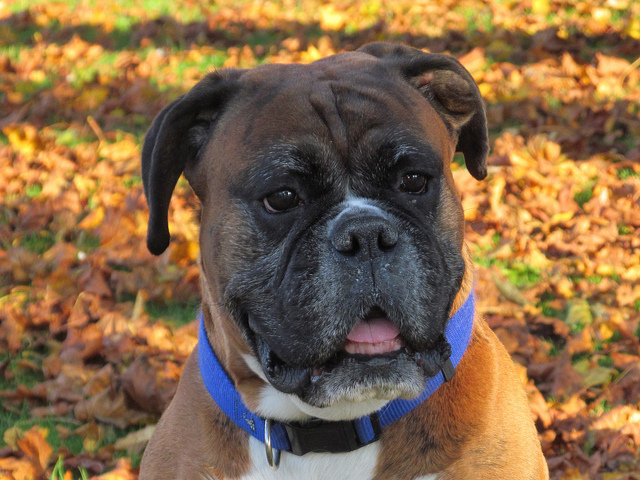 Acne in a Boxer dog is a major skin problem in this breed. These hormonal disproportions can be harmonized with age of a boxer dog but in some cases, they tend to continue even in the age of puberty. If acne in a boxer dog is causing scars then it requires proper attention of such boxer dog’s owner. Sometimes the pimples grow big and a boxer dog starts teasing or itching and resultantly there could be the appearance of red bumps.
Acne in a Boxer dog is a major skin problem in this breed. These hormonal disproportions can be harmonized with age of a boxer dog but in some cases, they tend to continue even in the age of puberty. If acne in a boxer dog is causing scars then it requires proper attention of such boxer dog’s owner. Sometimes the pimples grow big and a boxer dog starts teasing or itching and resultantly there could be the appearance of red bumps.
There can be an infection as well due to bumps and black-heads. It is recommended to give a bath to a normal boxer dog after every 3 weeks or so to keep it safe from acne. There can be several reasons for the outbreak of acne in a boxer dog. Sometimes, acne is the outcome of genetics. The rising of androgen level which is a kind of hormone during the adolescent period can be another reason.
A proper vet will take some essential test to make sure if a boxer dog is actually suffering from acne disease. Applying the benzoyl peroxide shampoo or gel during cleansing as recommended by your dog’s doctor can be a good idea. Furthermore, the veterinarian can prescribe some assertive types of creams, lotions or ointments as well.
Read more about Boxer Dog Acne
22.Boxer Dog snoring
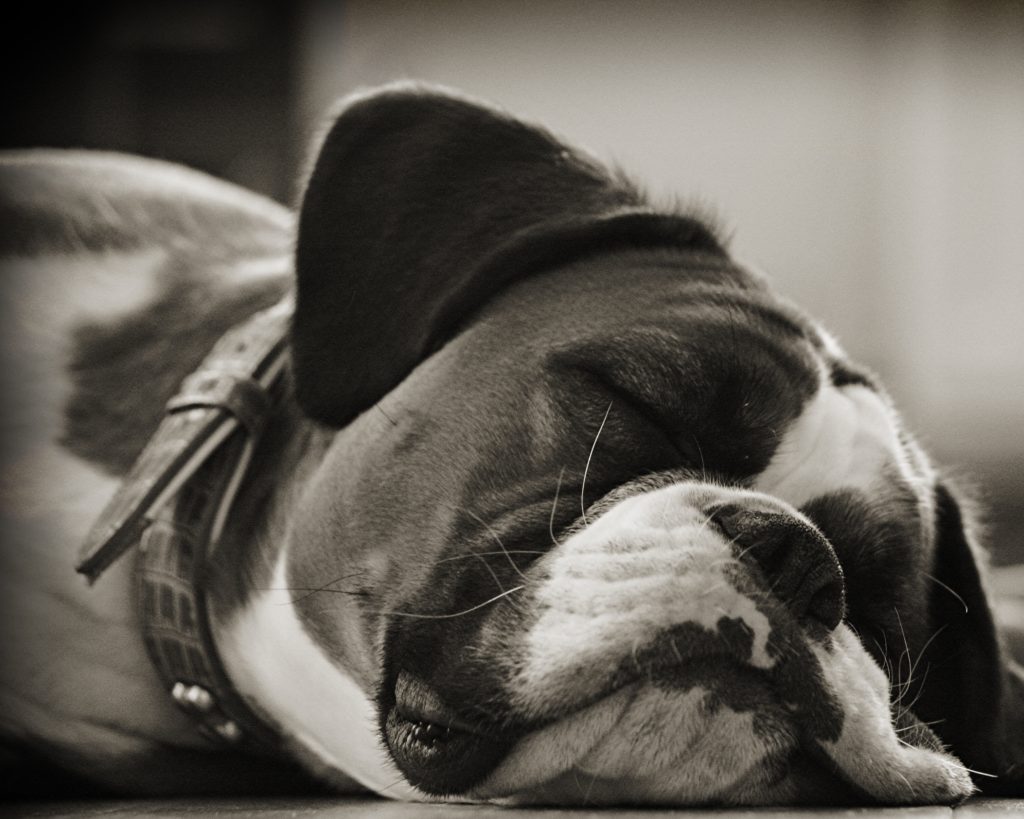 Boxer dog is a Brachycephali dog breed having constricted and shrunk volume of its head and it has confined and slender nostrils as compared to majority of dog breeds. They have a natural hindrance in breathing due to Brachycephalic Airway Obstruction Syndrome (BAOS). Before bringing a boxer dog at home, it is needed to be checked with a proper vet as it is a brachycephalic dog in order to identify any kind of serious breathing problem or unusual snoring. The sound of snoring in a boxer dog resemble to timber cutting or sawing which might be bubbling wet or hoarse grunting in some cases.
Boxer dog is a Brachycephali dog breed having constricted and shrunk volume of its head and it has confined and slender nostrils as compared to majority of dog breeds. They have a natural hindrance in breathing due to Brachycephalic Airway Obstruction Syndrome (BAOS). Before bringing a boxer dog at home, it is needed to be checked with a proper vet as it is a brachycephalic dog in order to identify any kind of serious breathing problem or unusual snoring. The sound of snoring in a boxer dog resemble to timber cutting or sawing which might be bubbling wet or hoarse grunting in some cases.
There can’t be an exact assessment of normal snoring of a boxer dog, but if it is bit louder during sleeping or some other type of noises are also being generated by a boxer dog even if it is awake or during physical activities, then the situation can be alarming. Extra body weight can also cause abnormal snoring.
If your boxer dog is affected with certain types of allergies, the snorting can be abnormal. The teeth infection can also react in shape of swelling of nasal parts and ultimately the abnormal snoring of such boxer dog.
Read more about Boxer Dog snoring
23.Demodectic mange in boxers
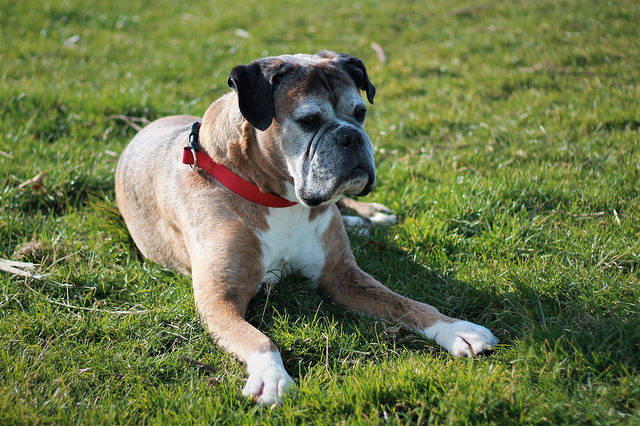 Demodectic mange is a typical skin disease, the boxer dog breed is prone to which. It is also called as Generalized Demodex, Demodicosis or Demodectic Mange. Demodectic mange is caused mainly by the Demodex mite, which develops its population over the coat of boxer, is normally invisible from the naked human eye. Demodectic mange starts affecting the body of a boxer dog in some of its areas which cannot be itchy all times. Sometimes these can appear looking like blistered skin over head, around its neck and near the legs and limb parts.
Demodectic mange is a typical skin disease, the boxer dog breed is prone to which. It is also called as Generalized Demodex, Demodicosis or Demodectic Mange. Demodectic mange is caused mainly by the Demodex mite, which develops its population over the coat of boxer, is normally invisible from the naked human eye. Demodectic mange starts affecting the body of a boxer dog in some of its areas which cannot be itchy all times. Sometimes these can appear looking like blistered skin over head, around its neck and near the legs and limb parts.
Sometimes, the fur also starts to be vanished around the affected areas of body of such boxer dog. In worst condition, it is known as Generalized Demodex or Demodectic Mange or Red Mange. This body rash can significantly increase and cover most of the areas of body, if not cured in time. There are some anti allergy soaps and shampoos available in the market which helps preventing such bacterial skin infections that are caused by scratching.
The treatment of Demodectic Mange or Red Mange in a boxer dog also requires cool temperament of the boxer dog owner as this disease can disturb physically to the affected boxer dog and mentally to its owner.
Read more about Demodectic mange in boxer dog
23.Boxer Dog Stomach and Intestinal Blockage
A boxer dog at any stage is proficient to ingest, swallow or gobble anything which can be ultimately dangerous for its digestive system. Sometimes it is as critical as it might also cause a terrible blockage. There are also numerous examples illustrated by many boxer dog owners, in which their boxer swallowed strange pieces that resultantly became the reason of stomach and intestinal blockage. Sometimes the incidents were so worse and deadly that lead to the death of those boxers. It is observed that boxer dogs can swallow objects like coins, underwear, socks, balls, marbles, toys, bones, small sticks, buttons and tampons which are normally available within their reach.
It is important to keep all dangerous objects away from your boxer dog. Due to the ‘Stomach and Intestinal Blockage’, there occurs the compilation of many solid and liquid wastes which can result in vomiting, gastric secretions and sometimes even dehydration. The vets normally adopt a diagnostic procedure for confirming gastric and intestinal blockage which is called an endoscopy. Even this method is sometimes useful to bring out the foreign bodies that may be the source of blockage. Additionally, some urine and blood tests can also be recommended for detailed analysis.
Read more about boxer dog stomach and intestinal blockage
24.Why Do Boxer Dogs Sit on Each Other? Or Sit on You!
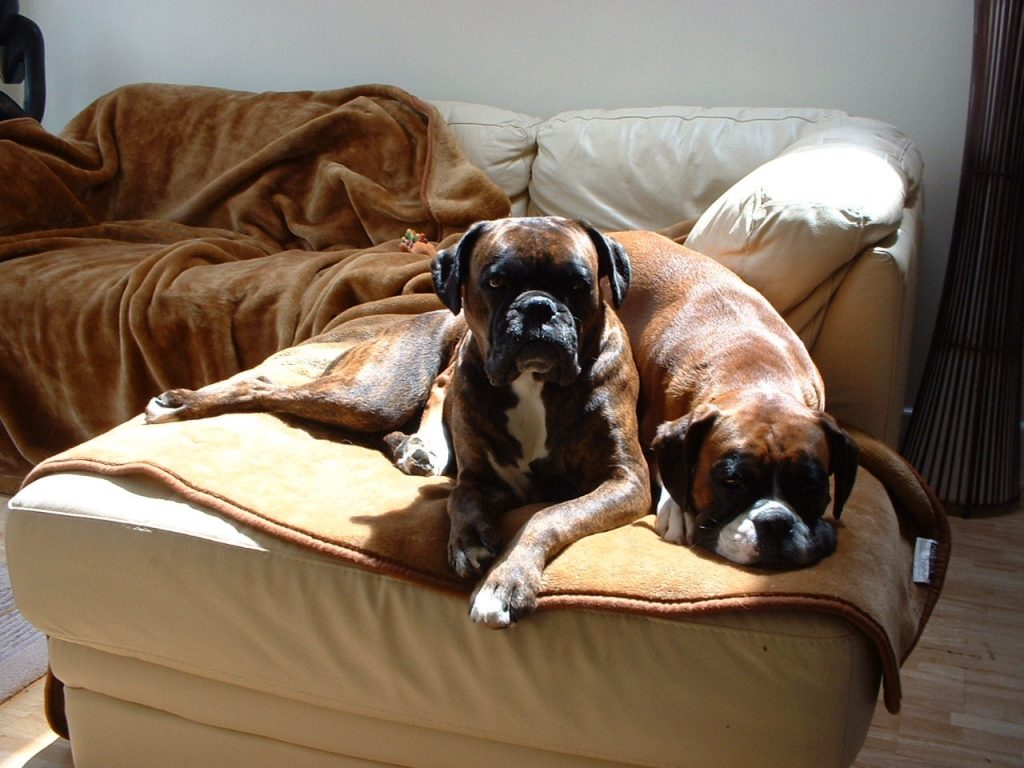 A boxer dog lover or owner is generally aware of the youthful and childlike demeanor of the boxer dog breed. They display normally in the same way by sitting on each other. Young ones are especially seen bonded with each other to feel protected and compassion. If they are grown up together, they’ll continue this routine even in their adulthood. This trend is usually observed, when boxer dogs are in relaxing mood. If two of them are resting in this position, the third one will definitely loosen up to join them.
A boxer dog lover or owner is generally aware of the youthful and childlike demeanor of the boxer dog breed. They display normally in the same way by sitting on each other. Young ones are especially seen bonded with each other to feel protected and compassion. If they are grown up together, they’ll continue this routine even in their adulthood. This trend is usually observed, when boxer dogs are in relaxing mood. If two of them are resting in this position, the third one will definitely loosen up to join them.
Boxer dog can sit on you or occupy your place as in this way; it is in search of achieving the attention and closeness of its owner. He just desires your consideration, infatuation and affection. However, he’ll never understand if he is placing itself on a child. It is you as an owner to train and make him understand, it is not feasible or good for a child.
When you have an adult boxer dog grown up by you and if you bring another younger dog to your household, then the sitting on the new one might be one of the ways to introduce him to acceptable attitudes
Read more about why Do Boxer Dogs Sit on Each Other?Or Sit on You!
25.Boxer Dog Water and Drinking Issues
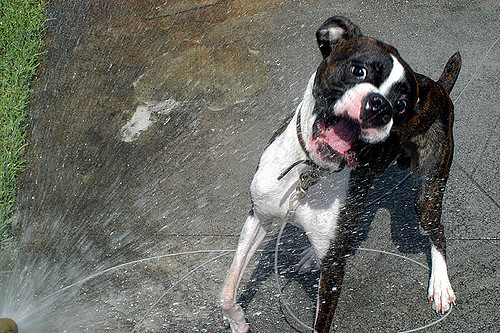 Safe water drinking is equally important as the balanced diet for your boxer dog. Water is life and its main function is not only to quench the thirst, but it also carries some critical nutrients that are ultimately transported to the cells existing in the boxer’s body. Those nutrients shall be helpful in streamlining the digestion system and their adequate absorption. Being a boxer owner, one must understand the quantity level for his/her boxer dog. It depends upon the physique, environment and the daily movement of the boxer dog.
Safe water drinking is equally important as the balanced diet for your boxer dog. Water is life and its main function is not only to quench the thirst, but it also carries some critical nutrients that are ultimately transported to the cells existing in the boxer’s body. Those nutrients shall be helpful in streamlining the digestion system and their adequate absorption. Being a boxer owner, one must understand the quantity level for his/her boxer dog. It depends upon the physique, environment and the daily movement of the boxer dog.
Always prefer fresh drinking water for your boxer dog. The tap water can be contaminated and can be hazardous especially in the areas, where there is scarcity of fresh water. If buying the expensive drinking water is not affordable for you, then at least you should have proper water filtration facility installed at your home.
The safe and healthy drinking is of dire importance for the health and safety of your boxer dog. Always keep a constant check on the drinking behavior and habits of your boxer dog, and if you find any abnormality, then never become negligent and consult with a qualified vet.
Read more about Boxer dog water and Drinking Issues
Boxer Dog age and diseases
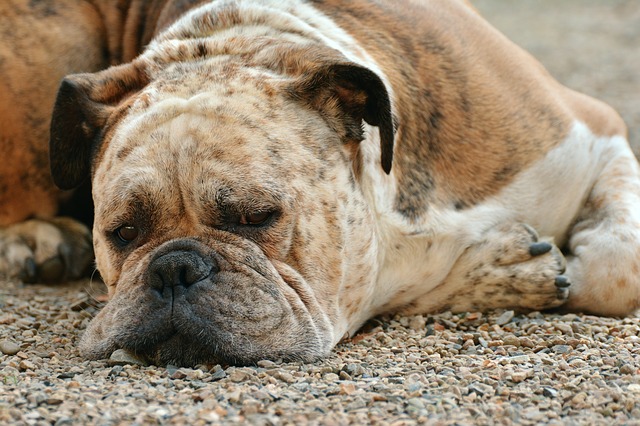 Boxer dog is although a medium-sized dog but unfortunately, like many larger dog species, the boxer dog has a shorter life span. The average life span of a boxer dog is approximately 10-12 years. The leading cause of the short life span of the boxer dog is the cancer disease. Nervous break-down or mental chaos is also another reason which affects the boxer dog and may lead it to the death.
Boxer dog is although a medium-sized dog but unfortunately, like many larger dog species, the boxer dog has a shorter life span. The average life span of a boxer dog is approximately 10-12 years. The leading cause of the short life span of the boxer dog is the cancer disease. Nervous break-down or mental chaos is also another reason which affects the boxer dog and may lead it to the death.
If unfortunately, your boxer dog is having any wound or injury on its body which might result in Trauma; it can also be severely dangerous to its life. Sometimes your boxer dog might also inherit some genetic disease from its predecessor. These diseases can also be so lethal or destructive in some cases. For the longevity of your boxer, its cleanliness is the most important thing. Brushing their teeth is also very important. A mentally relaxed and tension-free boxer is a healthier buddy. It will live longer.
Proper medications and getting your boxer vaccinated when required, will also add its lifespan. The life span of a boxer dog is also dependent upon the environment, circumstances or the lifestyle as well. Exercise is also a highly beneficial thing for the health and life of the boxer.
Read more about boxer dog age and diseases
Best dog food for Boxers
1.Boxer Dog Calorie Requirements
 This is important for any boxer dog owner to get the knowledge about the calories for boxer dog. Feeding with low calories diet is not the perfect science for the proper growth of the boxer dog. The boxer dog is an athlete dog which feels satisfactory, if it is met with its exercise and sport needs. In this case, the metabolism function is fast and the boxer dog needs some appropriate fats to be added in its daily diet.
This is important for any boxer dog owner to get the knowledge about the calories for boxer dog. Feeding with low calories diet is not the perfect science for the proper growth of the boxer dog. The boxer dog is an athlete dog which feels satisfactory, if it is met with its exercise and sport needs. In this case, the metabolism function is fast and the boxer dog needs some appropriate fats to be added in its daily diet.
Sufficient amount of daily calories intake by the boxer puppy is a positive sign which plays a vital role in its physical and mental growth. From 16 months to 24 months, the body of young dog is rapidly passing through many modifications and developments.
So the calories amount can be expeditiously changed as well. For your adult boxer dog, the calculation of the induction of calories in its daily diet should be done in accordance with its size. The larger the body of your adult boxer dog, it will require more calories. In the old age, still it is essential for the boxer dog owner to be aware, how many calories are needed for the dog to maintain its weight and energy.
Read more about Boxer dog Calorie Requirements
2.Fruits that a Boxer Dog Can Eat
 Your boxer just like you needs to have fruits to be added in their food chart. They are naturally low in fat, sodium, and calories. Latest researches denote, boxer dogs are in the middle that is also omnivore and also carnivore. Bananas can be useful as those are marvelous source of potassium, manganese, vitamin B6, vitamin C, fiber, biotin and copper. AKC also recommends as ‘Mango’ is enriched in fiber and it also contains vitamin A, B6, C, and E, so it is safe for your boxer dog to eat mangoes.
Your boxer just like you needs to have fruits to be added in their food chart. They are naturally low in fat, sodium, and calories. Latest researches denote, boxer dogs are in the middle that is also omnivore and also carnivore. Bananas can be useful as those are marvelous source of potassium, manganese, vitamin B6, vitamin C, fiber, biotin and copper. AKC also recommends as ‘Mango’ is enriched in fiber and it also contains vitamin A, B6, C, and E, so it is safe for your boxer dog to eat mangoes.
It is okay if you are giving watermelon in suitable proportion and in a moderate way to your boxer. Strawberries, blueberries and raspberries are also resplendent for boxers. Your boxer can also eat pears but it should be kept in mind, the pits and seeds are removed from pears handily.
You can also give pineapple which is full of vitamins to your boxer dog but in a moderate way. Peaches and their material are also luscious in taste and also beneficial for the boxer dog. Oranges should be given in a very smaller quantity. Neat and clean and properly washed fruits for boxer are always fine.
Read more about a Boxer Dog Can Eat
3.Boxer dog Diet Plan
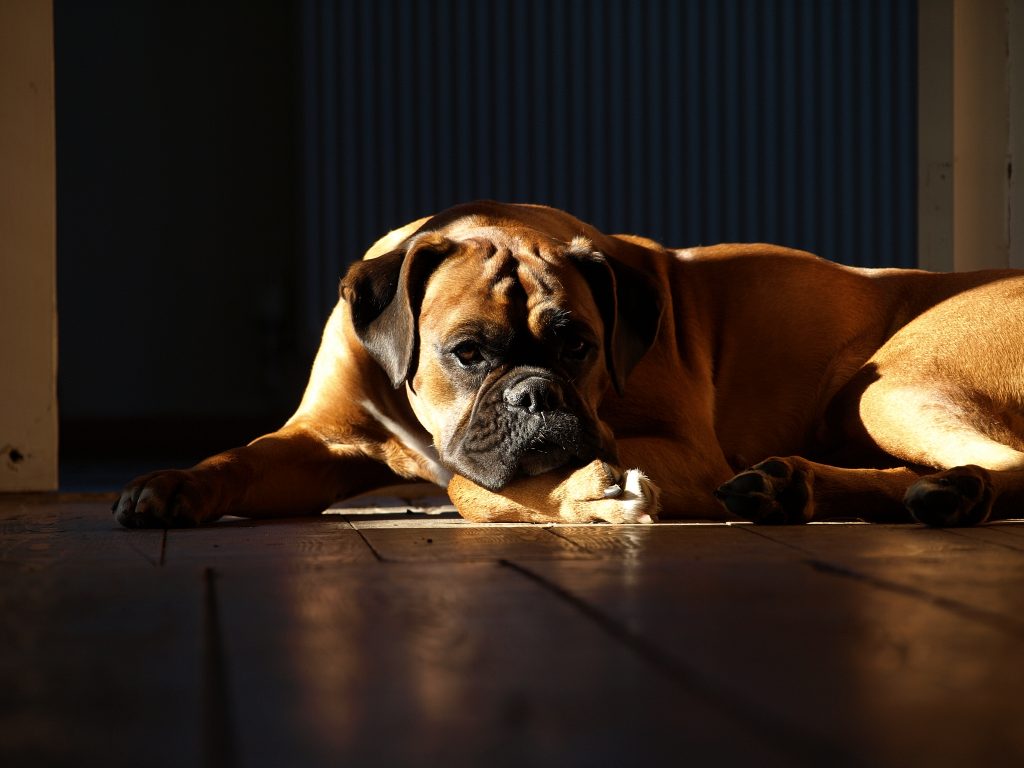 If you are planning a diet for your boxer dog, you should know about the food ingredients and its sources. It should have wonderful quality proteins and carbohydrates that can provide him with the required calories. From 4 weeks to 8 weeks age of a boxer puppy it is always suggested to be fed with its mom’s milk. However, when it is reached to the age of 4 months, it is a nice time to start with solid stuff but it should be done gradually. Normally from 2 to 6 months, it is better to feed your boxer puppy 3 times in a day.
If you are planning a diet for your boxer dog, you should know about the food ingredients and its sources. It should have wonderful quality proteins and carbohydrates that can provide him with the required calories. From 4 weeks to 8 weeks age of a boxer puppy it is always suggested to be fed with its mom’s milk. However, when it is reached to the age of 4 months, it is a nice time to start with solid stuff but it should be done gradually. Normally from 2 to 6 months, it is better to feed your boxer puppy 3 times in a day.
For a boxer puppy which is between 6 months to 1 years of age, it is good if you are feeding him with 2 meals in a day. Good diet plan for an adult boxer dog should be consisting of dog food having a blend of 40% meat, 50% veggies and 10% of carbohydrates material.
This is as much similar as you can take it as a healthy diet plan. Always vegetables, fruits and meat should be on priority for good food chart for adult boxer dog. When boxer dog is adult, it is better to feed him in accordance with its weight.
Read more about Boxer dog Diet Plan

